Consumer sentiment shifts rapidly, shaped not only by your company’s directives and strategies but also by external forces, such as viral trends, cultural movements, and economic forces. The brands that endure and adapt to these changes in real-time. Brand tracking is more than a periodic check-in – it’s essential for survival. By continuously monitoring brand health, companies can identify strengths, spot weaknesses, understand competitive positioning and adjust strategy accordingly.
But perception isn’t static. A brand with strong awareness today can lose relevance tomorrow if it fails to track how consumers feel, engage, and respond over time. To remain competitive, brands must continuously track their position in the market and be agile enough to adapt.
What is Brand Tracking, and Why Does it Matter?
Brand tracking measures a brand’s performance over time, helping companies identify shifts in the market, consumer trends, competitive trends, strengths, weaknesses, and opportunities to refine brand strategy.
Brand perception is fluid and influenced by consumer experiences, media narratives, and competitive shifts. Brand tracking helps companies answer critical questions:
- Is our brand positioning resonating with the right audience?
- How does our reputation compare to competitors?
- What messaging, campaigns, or brand attributes build consumer loyalty?
- Are external factors – economic shifts, social trends, or market disruptions – impacting our brand perception?
Key Elements of Brand Tracking
Brand tracking goes beyond surface-level metrics to assess a brand’s health and market position. Key components include:
- Brand Awareness: Measuring Recognition and Recall
- Unaided vs. Aided Awareness
- Top-of-Mind Awareness: The first brand a consumer thinks of in a category often signals market leadership and competitive strength.
- Brand Perception & Sentiment Analysis
- Consumer Attitudes and Associations: Understanding how consumers feel about a brand—and the attributes they link to it—is key to shaping brand identity. These should include both functional benefits and emotional benefits. As well as brand personality.
- Purchase Intent, Satisfaction & Customer Loyalty Metrics
- Likelihood of Purchase: Gauging how likely consumers are to choose a brand helps predict future sales.
- Satisfaction: Understanding brand satisfaction versus competitors.
- Net Promoter Score (NPS): Measuring customers’ willingness to recommend a brand indicates satisfaction and loyalty.
- Competitive Benchmarking
- Market Position Analysis: Comparing brand performance against competitors to identify strengths, weaknesses, and market opportunities.
- Share of Voice: Measuring a brand’s visibility in the market through media coverage and advertising reach.
- Media & Advertising Effectiveness
- Campaign Impact Assessment: Assessing how marketing efforts affect awareness, perception, and sales.
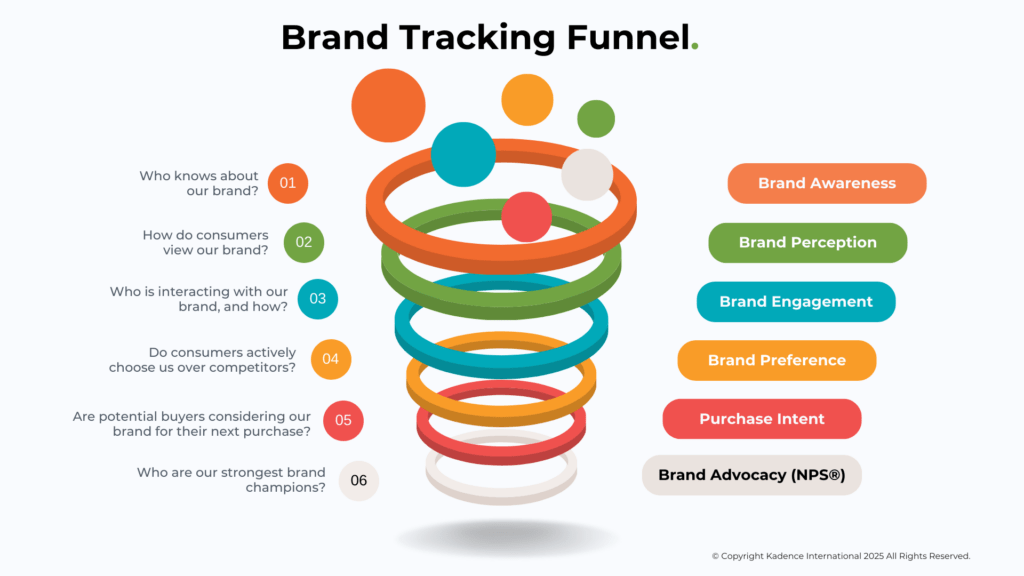
Turning Data into Strategy
Brand tracking only matters if insights lead to action. Using data strategically, companies can refine marketing, reposition products, and strengthen customer loyalty.
Identifying Strengths and Weaknesses Before They Become Market Issues
Tracking brand health helps brands pinpoint areas where they excel and where they are losing ground. Rather than relying on assumptions, brands that act on measurable shifts in consumer sentiment can adjust messaging and engagement tactics before losing relevance.
Optimising Marketing Campaigns
Effective marketing isn’t just about visibility; it’s about impact. Brand tracking measures how marketing efforts influence perception, loyalty, and purchase intent. If a campaign falls short, data allows brands to tweak real-time messaging rather than wait until the next cycle.
Benchmarking Against Competitors
Brand tracking is most powerful when measured against competitors. Comparing brand health metrics against competitors enables companies to identify gaps in positioning, capitalise on underserved markets, and anticipate industry shifts before rivals do.
Building Customer Loyalty
Brand tracking isn’t just for attracting new customers; it helps brands understand why existing customers stay or leave. Tracking loyalty metrics allows brands to implement better retention strategies, such as loyalty programs, improved customer service, or product innovation.
Brand Tracking Mistakes and How to Avoid Them
Even the best tracking methods fail if poorly executed. Avoid these common mistakes to ensure insights lead to action.
- Measuring Awareness Without Sentiment
A high awareness score means little if there are negative perceptions. Brands must pair awareness tracking with perception analysis to get a complete picture of their market position. - Tracking Without Business Goals
Brand tracking is useless if not tied to clear objectives. Tracking must support strategy, whether expanding markets, improving retention, or refining advertising. - Ignoring Qualitative Data
Numbers alone don’t tell the full story. Open-ended customer feedback and sentiment analysis reveal why brand perception shifts. - Failing to Act on Insights
Insights are useless if brands don’t act. Whether trust is eroding or a competitor is gaining ground, companies must adjust accordingly. - Overlooking Market Trends
Brand perception doesn’t exist in a vacuum. Economic shifts, cultural trends, and competitors shape public opinion. Effective tracking accounts for these factors.
Brand Tracking Is Not an Option—It’s Survival
Brand perception is a moving target. What consumers think today may not hold true tomorrow, and brands that fail to monitor these shifts risk becoming irrelevant. The market does not wait for companies to catch up; brands that do not track, analyse, and act on data are at the mercy of competitors who do.
Tracking isn’t just about data—it’s about influence. It reveals when a brand resonates or repels, when trust strengthens or erodes. The best brands spot risks before they escalate and seize opportunities before they go mainstream.
Market leaders don’t wait for a crisis to understand their position. They track, measure, and adapt before perception shifts beyond their control. A brand that isn’t tracking its relevance isn’t just falling behind – it’s already lost control of the narrative.
Get regular insights
Keep up to date with the latest insights from our research as well as all our company news in our free monthly newsletter.
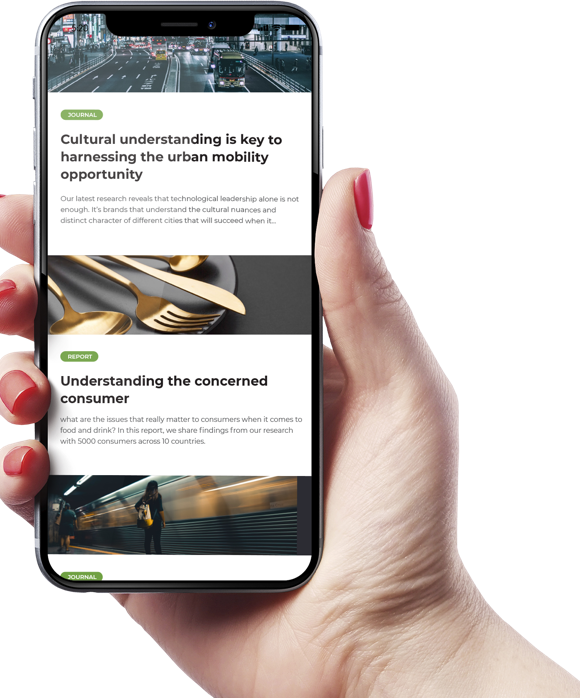
Before they reach the target market, products or services always start off as unproven ideas. But in order to avoid costly failures, businesses need to understand whether or not they’ll be a hit with consumers.
What Is Concept Testing and Why It’s Essential for Product Development
Concept testing is the process of using qualitative or quantitative research to evaluate your product ideas ahead of launch. It enables you to understand which features are likely to be popular with the target audience, and which may require refinement.
Key methodologies include in-depth interviews, online communities, and structured testing surveys—each designed to gather actionable feedback on your potential product or service. If you’re unfamiliar with the broader benefits of concept testing, our guide to concept testing provides a helpful overview.
The Role of Concept Testing in Market Readiness
Testing product ideas with your target audience enables you to optimize your offering before market entry. By understanding consumer reactions early, businesses can fine-tune features, adjust positioning, and reduce the risk of costly missteps. A robust concept testing strategy dramatically boosts your chances of success—because it replaces assumptions with evidence.
Even seemingly minor product features can profoundly impact outcomes. Concept testing allows you to uncover which elements your potential customers value most. It also gives you clarity on what to include, what to revise, and what to drop before the product ever hits the shelf.
To explore this in the context of innovation pipelines, see our article on why concept testing is important.
Product and Concept Testing in Research and Development
Behind every successful product lies a thoughtful research and development process—and concept testing plays a vital role within it. At Kadence, we’ve partnered with some of the world’s most recognizable brands to transform promising ideas into commercially viable solutions through strategic product and concept testing.
When done correctly, concept testing not only validates the idea but can help shape its final execution—from functionality to pricing to messaging. But how do you test a product concept effectively?
Below are five tested approaches that leading companies use to assess and improve product ideas before launch.
1. Use Concept Testing Surveys to Gauge Overall Appeal and Prioritize Ideas
A concept testing survey can be one of the most powerful tools in your product development toolkit. These surveys can reach large, targeted audiences and provide robust quantitative data on how different ideas resonate.
You can test multiple product concepts to understand their relative appeal and determine which are worth pursuing. Surveys allow you to evaluate core attributes—like usefulness, differentiation, and pricing thresholds—by asking the right questions of the right people.
Often, a Likert scale is used to measure attitudes toward each concept, capturing nuance in consumer perception. It’s critical that your respondent base reflects your actual target market. If not, your results will lack reliability.
A strong concept testing survey can also identify which geographies, age groups, or demographic segments show the highest intent, helping you make smarter investment and go-to-market decisions.
We explore this method further in our examples of product testing article.
2. Conduct Conjoint Analysis to Prioritize Features and Trade-Offs
Conjoint analysis is a statistical technique used to determine how people value different attributes of a product. Rather than asking consumers what they prefer, it uncovers what drives decision-making by presenting combinations of product features for comparison.
For example, in a product testing scenario, respondents might compare variations in price, packaging, and functionality—revealing the trade-offs they’re willing to make. This method helps marketers and product teams categorize features into must-haves and nice-to-haves and assess how changes impact perceived value.
However, it’s important to avoid overwhelming participants with too many combinations. A well-structured conjoint study should be digestible, yet thorough enough to yield insights that guide real-world product planning.
If you’re navigating new product development, explore our dedicated page on concept testing in innovation pipelines.
Get regular insights
Keep up to date with the latest insights from our research as well as all our company news in our free monthly newsletter.

3. Use Monadic Product Testing to Avoid Bias and Improve Clarity
Monadic testing presents each product concept to respondents individually, rather than side-by-side. This allows for cleaner, unbiased evaluations of each idea in isolation—particularly useful when you want to gather focused feedback without the influence of direct comparison.
Each participant evaluates a single concept based on criteria such as purchase intent, uniqueness, relevance, and likelihood of recommendation. By isolating the exposure, you can assess raw consumer sentiment and identify whether the idea stands on its own merits.
This approach is often used when testing early-stage concepts or when you want to avoid the cognitive fatigue that can come with multiple exposures. It’s especially useful when the concepts being tested are fundamentally different in form or positioning.
To understand when this method makes the most impact, our overview of concept testing approaches provides more detail.
4. Apply Comparative Concept Testing to Measure Preference and Differentiation
Comparative concept testing places two or more ideas side-by-side and asks respondents to choose their preferred option. This is a practical method for evaluating relative strengths—ideal when you’re deciding between multiple product names, taglines, packaging options, or functional benefits.
While this technique is fast and cost-effective, it does come with a caveat: more polished or visually appealing concepts often outperform less refined ones, even if the core idea is stronger. To mitigate this, ensure all concepts are presented at a comparable fidelity and that creative variables don’t distort results.
This form of testing is particularly valuable when time is limited and decisions must be made quickly. It’s frequently used in packaging research, ad testing, and feature prioritization.
Looking to understand more about how this method fits into the larger testing strategy? See our 5 reasons concept testing is important article for insights into its strategic role.
5. Conduct Concept Screening for Early-Stage Idea Elimination
When you’re at the beginning of the innovation process and have a wide array of ideas, concept screening helps you eliminate weaker options early. This method relies on quick-read formats—typically short descriptions or visual summaries—delivered to a broad sample of your target audience.
The goal is not deep feedback, but rather directional input: Which ideas generate interest? Which fall flat? Which warrant further development?
Concept screening is particularly useful in the fuzzy front end of product development, when you’re working through broad ideation and need to narrow the field efficiently. It’s often followed by more robust methods like monadic or conjoint testing once a shortlist has been established.
To explore how this fits into the research process, our guide to concept testing in new product development explains how to integrate screening into your overall validation plan.
Choosing the Right Concept Testing Method for Your Product
With so many ways to test product ideas, how do you choose the right one? It depends on where you are in the development cycle, how many concepts you’re testing, and what kind of feedback you need.
- Early-stage ideation: Use concept screening to eliminate weaker ideas and highlight front-runners.
- Refinement phase: Choose monadic or sequential monadic testing to evaluate each concept independently and in detail.
- Comparative decisions: Use comparative testing when you’re deciding between two similar options, such as logos or slogans.
- Feature prioritization: Apply conjoint analysis to understand which elements drive value and which are expendable.
If you’re launching a product in a new market, it’s especially important to localize your testing methods. What works in one region may not resonate in another. Our global teams at Kadence can help adapt methodologies for cultural context and ensure you’re getting feedback that’s not just statistically significant—but actually useful.
To learn more about adapting testing to different markets and business models, our full guide to concept testing outlines strategic considerations in depth.
Turning Insight Into Impact Through Concept Testing
Concept testing isn’t just a checkpoint—it’s a strategic advantage. Brands that build feedback into the earliest stages of development don’t just avoid failure; they design more meaningful products, faster. Whether you’re refining an MVP or comparing go-to-market options, choosing the right testing method can be the difference between assumptions and assurance.
The most successful businesses are those that stay curious—constantly validating, adjusting, and aligning their offer with what real consumers value. In a market defined by shrinking attention spans and rising expectations, the best product isn’t always the one with the best features. It’s the one that speaks most clearly to what people truly want.
Ready to Validate Your Next Big Idea?
If you’re developing a new product or repositioning an existing one, concept testing can help you uncover what your audience values most—and where your idea stands out. From feature prioritization to launch messaging, we help brands remove guesswork and build with confidence.
Explore our concept testing services or request a tailored proposal to speak with our team.
Late one evening in Lagos, 22-year-old Chika is scrolling through TikTok, eyes fixed on a local influencer demoing the latest face serum. She watches the 30-second video twice, screenshots the product, and toggles over to Jumia to compare prices, scanning reviews that look a little too polished to be real. Before checking out, she sends a message to her cousin in Ibadan: “Have you tried this one? Is it legit?” Only after a thumbs-up and a money-back assurance from the seller does she complete the purchase – on mobile, of course.
This isn’t an isolated case. It’s a snapshot of how the next billion consumers will shop, click, and connect.
While Western economies grapple with saturation, inflation, and shifting loyalty, the momentum is migrating – toward Southeast Asia, Africa, and parts of Latin America. These regions are no longer just “emerging markets.” They are where the most dynamic, mobile-first, and digitally sophisticated consumers are coming of age.
The numbers make the case undeniable. According to the United Nations, over 85% of global population growth through 2050 will come from Africa and Asia. The GSMA reports that mobile internet penetration in Sub-Saharan Africa is set to reach 50% by 2025, up from 28% in 2019. Meanwhile, the World Bank highlights how smartphone adoption is leapfrogging traditional infrastructure, giving rise to an entire generation that skipped the PC era entirely.
But these consumers are not easily won. They are bilingual and bicultural, equally fluent in local slang and global memes. They are digitally native but deeply mistrustful, having grown up in online ecosystems rife with scams, misinformation, and empty brand promises. And they are forcing brands – both global and local – to rethink what it means to earn attention, deliver relevance, and build trust in the age of hyper-connectivity.
This is not just a demographic shift. It’s a behavioural revolution. And it’s already underway.
Meet the Next Billion: Demographics, Access, and Expectations
This new wave of consumers is young, connected, and coming online fast. In markets like Nigeria, Indonesia, Vietnam, and the Philippines, the median age hovers around 25. These are societies where more than half the population wasn’t yet born when Facebook launched – and for them, digital engagement isn’t an evolution; it’s a native state.
Urbanisation is accelerating across these regions, but it’s not confined to megacities. Second- and third-tier cities are becoming powerful engines of growth, fueled by digital access and rising educational attainment. In Vietnam, for instance, over 94% of youth are literate, and the number of university graduates has doubled over the past decade. Similarly, Nigeria’s youth enrollment in tertiary education is climbing, despite infrastructure constraints. With education comes language dexterity: millions speak at least two languages – one local, one global – and they switch between them instinctively, depending on the context, platform, or audience.
If their predecessors logged onto the internet, this generation lives inside it – and does so almost exclusively via smartphone. In Indonesia, smartphone penetration has surpassed 75%, with apps like Tokopedia, Gojek, and Shopee becoming gateways to everything from groceries to financial services. In sub-Saharan Africa, handset affordability and prepaid data plans have made mobile the default medium for learning, shopping, and socialising. The desktop? Many have never touched one.
Browser-based experiences are increasingly irrelevant. Instead, this generation navigates a constellation of apps, each with its own cultural role. WhatsApp is for family, Instagram for aspiration, TikTok for entertainment, and Telegram or local forums for unfiltered information. Platform behaviour is deeply segmented and purpose-driven. Brands attempting to force a uniform message across channels are quickly tuned out.
And while their tech habits may look similar from a distance, the nuances run deep. In Nigeria, digital spaces are often leveraged as tools for activism and community solidarity. Mistrust in institutions has made peer recommendations and online reputation more powerful than formal brand campaigns. By contrast, in Indonesia, religious and cultural values shape how products are perceived and promoted – especially in sectors like fashion, beauty, and food. Vietnamese consumers, on the other hand, exhibit a high degree of tech optimism, embracing e-wallets and livestream commerce, but place enormous emphasis on product quality and after-sales service, driven by prior experiences with low-cost imports.
These differences matter. What unites the next billion is their digital fluency, but what distinguishes them is the lens through which they evaluate brands. A price drop may trigger interest in Nigeria, but in Vietnam, durability and performance often take precedence. In Indonesia, localised design or halal certification may be the tipping point. The common thread is that these consumers are not passive recipients of global marketing – they are active participants, savvy navigators, and, increasingly, vocal critics.
To engage them, brands must move past old assumptions about emerging markets being homogenous or easily won with scale. What’s unfolding is a more complex, more nuanced, and more demanding consumer environment – and it’s being shaped not just by demographics, but by deep-seated expectations forged in mobile-first, culturally hybrid, and rapidly evolving societies.
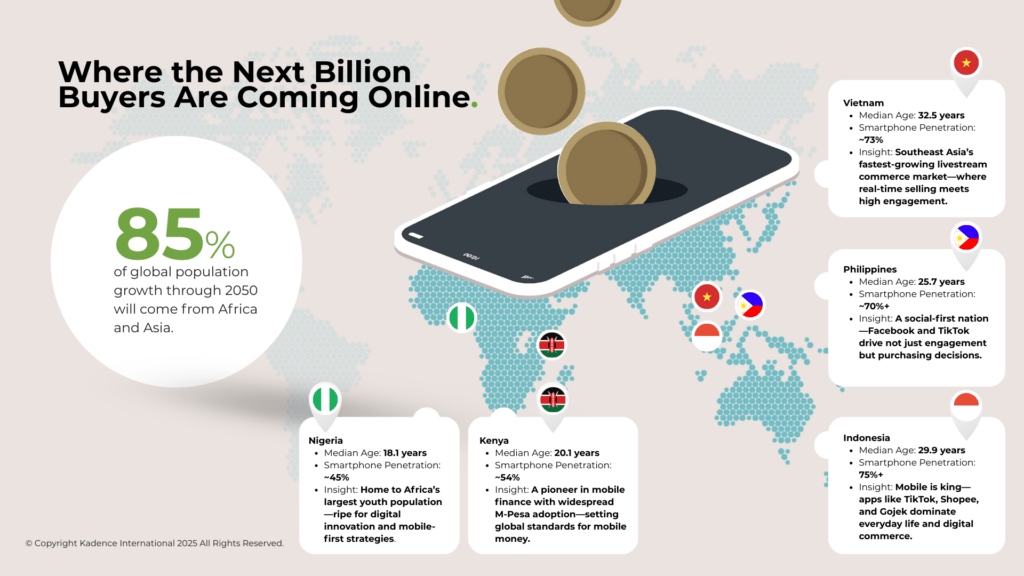
Mistrust Is the Default Setting
For many of the next billion consumers, scepticism isn’t a reaction – it’s a reflex. Decades of unreliable infrastructure, political instability, and inconsistent enforcement of consumer rights have conditioned buyers to approach brands and platforms with guarded caution. In these markets, trust is not assumed; it’s earned slowly and lost quickly.
The scale of the challenge is significant. According to Edelman’s 2024 Trust Barometer, trust in institutions – including businesses – remains markedly lower in developing regions than in developed ones. In Nigeria, only 42% of respondents said they trust brands “to do what is right,” compared to 62% in the UK. In Indonesia, that figure was closer to 50%, but even there, trust is often linked to familiarity rather than formal reputation – people tend to trust people, not corporations.
This backdrop has fueled the rise of peer-to-peer influence as a dominant decision-making force. In the Philippines, Facebook community groups like “Online Budol Finds” (slang for impulsive purchases) function as real-time marketplaces and review boards, where users share unfiltered opinions about products, pricing, and service. In Kenya, WhatsApp groups play a similar role, serving as both watchdog and validator in a system where traditional consumer protections are weak or absent. Even in Vietnam, where e-commerce infrastructure has rapidly improved, 54% of online shoppers say they rely on recommendations from friends or family over brand messaging, according to Statista.
This preference for informal verification mechanisms stems from bitter experience. Counterfeit goods remain a rampant issue across markets – from fake electronics in Ghana to diluted skincare products in Indonesia. In response, many consumers have developed an internal checklist: check the seller’s social proof, confirm the payment method, look for real customer images, and verify delivery policies. Brands that fail even one of these checks are likely to be discarded in seconds.
At the same time, digital mistrust is compounding the issue. Scams, phishing attacks, and fake reviews have tainted the e-commerce experience. The GSMA estimates that more than 40% of mobile internet users in Africa and Southeast Asia have experienced some form of online fraud or misleading advertising. In Indonesia alone, the National Cyber and Crypto Agency reported over 190 million cyberattacks and suspicious traffic incidents in 2023.
In this climate, even influencer marketing – a strategy once thought to fast-track trust – has grown less effective. In Vietnam, consumers increasingly question whether influencers are being paid to promote products they don’t actually use. The same holds true in Nigeria, where audiences are savvy enough to distinguish between genuine recommendations and sponsored scripts. The result is a gradual shift toward micro-influencers and community advocates, whose endorsements feel more relatable and less rehearsed.
The implications for global brands are profound. Standard top-down marketing no longer carries weight. Instead, trust must be layered in – through reliable service, consistent messaging, transparency in returns and refunds, and responsiveness on the platforms where consumers are active. Brands must also recognise the importance of publicly visible customer interactions. A fast, empathetic reply to a complaint in the comments section may matter more than a million-dollar ad campaign.
Trust, in this context, is not a brand asset; it’s a user experience outcome. And in a market where every interaction becomes a review, the next billion are watching, judging, and sharing – with or without you.
The Battle for the First Page (or First Screen)
For the next billion consumers, the path to purchase doesn’t begin with a browser search – it starts with a scroll. Discovery has shifted from keywords to content, from desktop search bars to full-screen video, and from global search engines to localised social ecosystems. As a result, the first screen – what shows up in a feed, on a homepage, or in a chat group – has become the most valuable real estate in the customer journey.
In Indonesia, 71% of internet users aged 16–24 say they use social media as their primary source for researching brands, according to DataReportal 2024. In Nigeria, that figure is nearly identical. TikTok, Instagram Reels, Facebook Marketplace, and YouTube Shorts aren’t just distractions – they’re digital storefronts where decisions are made in real time, often before a brand’s official website is ever visited. The lines between content, commerce, and community have all but vanished.
And while this trend is visible globally, its intensity in emerging markets is distinct. A key reason: data affordability drives platform choice and usage behaviour. Telecom bundles that include free access to Facebook or WhatsApp often influence which platforms dominate attention. In the Philippines, for example, “Free FB” packages have made Facebook one of the most deeply entrenched platforms in the country’s digital culture – so much so that some users mistakenly believe it is the internet.
The importance of platform-specific strategy can’t be overstated. In Vietnam, product discovery frequently occurs through livestream commerce on TikTok Shop, where real-time interactions foster a sense of authenticity. In Kenya, small businesses routinely post promotions through WhatsApp Status or Telegram channels, bypassing traditional ad formats altogether. In Nigeria, where Twitter (now X) has a strong political and cultural presence, product conversations often unfold in threads filled with memes, humour, and direct audience engagement.
But it’s not just about where brands show up – it’s about how they’re experienced in the moment. Load speed, image optimisation, and mobile UX have a direct impact on trust and retention. According to Google, 53% of mobile users in emerging markets will abandon a page that takes longer than three seconds to load. And that’s not just about tech – it’s about expectations. These consumers are used to fast, seamless, and low-friction digital experiences. Anything less suggests the brand doesn’t understand them.
Just as critically, language and localisation now serve as first impressions. A landing page that defaults to English – or worse, uses awkward machine translations – can signal cultural detachment. By contrast, content tailored in local languages, with region-specific slang and visual references, is seen as a mark of respect and investment. It says: we’re not just here to sell; we’re here to understand.
In a space where attention is both fleeting and fiercely fought over, success no longer goes to the loudest voice or biggest budget. It goes to the most culturally fluent, visually intuitive, and platform-native presence. Winning the first screen isn’t about visibility alone – it’s about resonance.
The Rise of Reverse Aspiration and Quiet Power
Western brands once assumed that success in emerging markets meant becoming aspirational – symbols of modernity and affluence. But for today’s mobile-first generation, the tables are turning. Increasingly, it is not global prestige that earns admiration, but local relevance. In place of overt aspiration, there’s a growing sense of pride in indigenous culture, self-made success, and digital independence. What’s emerging is a quiet power: consumers who no longer seek to imitate the West, but expect brands – foreign and domestic – to meet them on their terms.
Across Southeast Asia and Africa, there’s a perceptible shift from status to substance. In Nigeria, youth are driving a surge in support for homegrown fashion labels like Orange Culture and Ashluxe – brands that blend global aesthetics with distinctly African narratives. A 2023 Euromonitor report found that 64% of Nigerian Gen Z consumers said they prefer to buy local brands that reflect their identity, even when international options are available.
This isn’t limited to apparel. In Indonesia, the halal cosmetics market has seen explosive growth, not merely as a religious preference but as an expression of cultural values. Brands like Wardah and Emina now rival – or outperform – multinational competitors in brand recognition among young women. These brands don’t compete by mimicking Western tropes. They succeed by embedding themselves in the rhythms of local life, from religious observances to beauty standards shaped by regional influencers rather than global celebrities.
The same dynamic is playing out in Vietnam’s tech sector, where local e-wallets like MoMo are outpacing foreign fintech entrants – not because of superior technology but because they better understand the daily behaviours, payment rituals, and security concerns of the Vietnamese consumer. According to a 2023 study by Decision Lab, MoMo enjoys over 60% brand preference among young urbanites, in part due to its partnerships with local merchants and integration into everyday routines like topping up phone credit or paying utility bills.
Meanwhile, global culture is increasingly being shaped by these same markets. Afrobeats, once a niche genre, now tops international charts. Thai skincare routines are influencing global beauty trends. Filipino content creators are gaining global followers on TikTok not because they adapt to global norms, but because they confidently showcase their own. In this way, reverse aspiration is not just a rejection of old hierarchies – it’s an export of influence.
For brands, the lesson is clear: you are not the centre of the story. Consumers no longer measure themselves against your brand identity. Instead, they measure your brand against their values, communities, and cultural fluency. Products must be flexible, not fixed; branding must adapt, not dictate.
The rise of reverse aspiration doesn’t signal hostility toward global brands – it signals maturity. These consumers aren’t trying to join the global mainstream. They are the mainstream – digitally savvy, culturally proud, and shaping the conversation on their own terms. And they expect brands to understand that before making their pitch.
Strategies to Earn Attention and Trust
Capturing the attention of the next billion is not a matter of flashy creative or inflated ad budgets. These consumers are deliberate and discerning, quick to disengage from brands that don’t meet their standards or speak their language – both literally and figuratively. Trust is not a funnel; it’s a framework. And it requires consistent, intentional action across every touchpoint.
1. Hyper-localisation isn’t optional – it’s foundational.
For emerging market consumers, brand credibility is tightly linked to cultural fluency. It goes beyond simple translation to a full embrace of local values, references, and usage contexts. In Vietnam, the delivery app Baemin differentiated itself by infusing its platform with witty Vietnamese slang, inside jokes, and hyper-specific product categories – earning loyalty not through function, but through cultural intimacy. In Kenya, Safaricom’s M-Pesa succeeded not just as a mobile payments tool, but because it was built around the realities of an unbanked population, with offline integration and SMS functionality that anticipated connectivity challenges.
2. Trust is built in the micro-moments.
In high-trust economies, consumers might forgive a misstep. In low-trust markets, every interaction matters. A delayed delivery, a missing refund, or a slow response to a query can permanently damage perception. In Indonesia, beauty brand Sociolla won favour by offering guaranteed authentic products, tracked delivery, and a no-hassle return policy – features that directly addressed consumer anxieties in a market flooded with counterfeits. Transparency, speed, and customer service are not operational choices; they are brand positioning strategies.
3. Community voices trump corporate messaging.
The age of the polished brand ambassador is fading. Peer influence, especially from micro-influencers and everyday content creators, now holds more sway. These are people with modest followings but high engagement, often speaking in native dialects or regional slang. In the Philippines, Shopee’s partnership with grassroots creators in smaller cities – rather than national celebrities – helped drive adoption among new internet users. Brands that co-create with local voices, elevate real customer stories, and share behind-the-scenes content signal a level of openness that consumers find relatable and reassuring.
4. Simplification drives conversion.
The mobile-first mindset means consumers expect streamlined interfaces, fast-loading pages, and frictionless payment processes. The most successful brands eliminate barriers rather than adding features. In India, Meesho – a platform that allows users to resell products through WhatsApp and Facebook – gained explosive traction not by competing on price or product, but by simplifying commerce to match the rhythms of informal entrepreneurship. Especially in markets with lower digital literacy or inconsistent connectivity, simplicity is not just convenient – it’s empowering.
5. Offer real value, not just marketing.
Beyond product benefits, brands that offer utility, knowledge, or community are more likely to earn sustained engagement. During the pandemic, Vietnam’s Vinamilk launched a nutrition education series across Facebook Live, fronted by local pediatricians and nutritionists. The effort was not overtly commercial, but it positioned the brand as a trusted source in a time of uncertainty – building long-term brand equity. Similarly, in Africa, MTN’s “Y’ello Hope” campaign provided remote learning support and free data for health workers, deepening brand connection far beyond mobile service.
6. Show up where it matters – and stay.
Too often, international brands treat emerging markets as seasonal experiments, testing campaigns without long-term investment. But consistency is critical. Consumers notice who’s around during key holidays, national events, and crises – and who disappears when results don’t come quickly. Building trust means being present, listening actively, and responding quickly, even when it’s not convenient. It means moving from transactional to relational.
Attention and trust are hard-won in these markets – but not impossible. Brands that succeed will be those that listen before speaking, localise without diluting, and deliver value at every step. It’s not about cracking a code – it’s about showing up, with respect, relevance, and reliability.
What the Next Billion Means for Global Strategy
The next billion consumers will not just change where companies grow – they will fundamentally reshape how companies think. For too long, emerging markets have been treated as the final frontier for global brands – places to extend reach and scale after success was achieved elsewhere. That model is not only outdated; it’s strategically short-sighted.
In markets like Vietnam, Kenya, and the Philippines, consumer expectations are being forged under entirely different conditions: mobile-first access, economic volatility, rapid urbanisation, and a deep mistrust of centralised systems. The result is a set of behaviours that are more adaptive, more sceptical, and often more innovative than those seen in mature markets. Consumers here are not merely catching up – they are setting new standards.
Rather than viewing these markets as extensions of Western playbooks, companies should see them as innovation testbeds. Take mobile commerce: features like embedded payments, one-click checkout via messaging apps, or app-free transactions are not novelties – they are necessities driven by constraints around bandwidth, infrastructure, and financial inclusion. Yet these same constraints are producing solutions that may become best practices globally.
Similarly, platform design in these regions often centres on immediacy, low data consumption, and local integration. Global teams should be asking: What can we learn from the success of super apps in Southeast Asia? From the rise of voice notes and vernacular language content in India? From trust mechanics built into informal commerce networks across West Africa? These are not fringe behaviors – they are indicators of where global user expectations are headed.
The ability to operate in these ecosystems requires more than translation. It demands cultural intelligence, operational flexibility, and a long-term mindset. Localisation must move beyond interface tweaks to encompass everything from payment methods and logistics to influencer partnerships and community engagement. A product launch is no longer the finish line; it’s the beginning of a multi-year trust-building process.
This shift calls for investment – not just in marketing – but in on-the-ground research, in building local teams with decision-making power, and in systems that can adapt quickly to feedback loops. The brands that will thrive are those that listen early, prototype fast, and refine continuously. That’s not reactive – it’s resilient.
The next billion are not waiting to be discovered. They are already online, already informed, already choosing. But they are choosing carefully. Their loyalty isn’t earned by reputation – it’s earned by repetition: consistent delivery, relevance, and respect over time.
What we’re seeing isn’t a short-term trend – it’s a structural redefinition of what global success looks like. And in this new equation, the old formulas – centralised control, broad generalisations, and push marketing – no longer hold. The competitive edge will belong to those who approach these markets not as territories to conquer, but as partners in evolution.
Because when consumers are multilingual, mobile-first, and mistrustful by design, brand engagement becomes a privilege – not a right. The challenge is not whether companies can reach them. It’s whether they can rise to meet them.
Get regular insights
Keep up to date with the latest insights from our research as well as all our company news in our free monthly newsletter.

Wearables aren’t fringe anymore. Once seen as fitness accessories for gym-goers and early adopters, smartwatches and health trackers are becoming everyday essentials. In the first quarter of 2024 alone, global shipments of wearable devices hit 113 million units – an almost 9% jump compared to the year before. And that’s despite persistent inflation and consumer pullback across key markets.
What’s shifting? People are treating these devices less like gadgets and more like tools for managing stress, sleep, and overall health. Consumers are using them to take control – sometimes even before they know something’s wrong. And tech companies are keeping pace, building in more sophisticated health features, wrapping them in sleek design, and expanding their reach far beyond Silicon Valley.
China, for example, led the world in wrist-worn device shipments through most of 2024, with almost 46 million units sold in just the first three quarters. Japan’s older population is increasingly using wearables to monitor vitals and stay independent longer. In the US and UK, mainstream use is now less about steps and more about holistic wellness. Meanwhile, in Southeast Asia and India, lower-cost models are making wearables accessible to first-time buyers – especially younger users who want health data but don’t need an Apple logo to get it.
This rise isn’t just about health – it’s about habits. The adoption curve shows that consumers are steadily folding digital health tracking into their everyday routines, reshaping not only how we think about wellness but also how we’ll live and age in the years ahead.
From step counters to personal health assistants
The evolution of wearables mirrors a larger shift in how we define health. A decade ago, a fitness tracker was mostly just that – a tool for counting steps or logging runs. Now, it’s a wrist-worn health hub, checking heart rhythms, analyzing sleep, detecting stress, and even alerting users to abnormal vitals before symptoms appear.
This transformation hasn’t just changed the product – it’s reshaped the market. What started with athletes and early tech adopters has now spread across age groups and income levels. Smartwatches are on the wrists of office workers in Singapore, older adults in Tokyo, commuters in London, and Gen Z students in Delhi. And the demand isn’t slowing.
Global sales of wearables reached over $84 billion in 2024, with projections putting the market on track to more than double by 2030. That growth is being powered by consumers in Asia, where China continues to dominate volume thanks to homegrown brands, and where India and Southeast Asia are seeing rising uptake of budget-friendly devices. In Japan, demand is strongest among an ageing population who are using wearables for peace of mind – keeping tabs on heart rate, sleep, and medication reminders.
The US and UK still lead when it comes to higher-end models and paid health tracking subscriptions. But what’s consistent across regions is the shift from passive to active wellness. As one analyst at Canalys put it recently, “We’re watching wearables move from fitness to full-spectrum lifestyle tech.”
And while device makers keep layering in new features – temperature sensing, stress tracking, blood oxygen levels – it’s the behavior behind the screen that matters most. Consumers aren’t just buying wearables; they’re changing how they relate to their own health. What’s changing fastest isn’t the tech – it’s how people are folding it into their everyday decisions.
Consumer Adoption Across Generations and Borders
Younger consumers may be driving volume, but wearables are winning over every generation – for very different reasons.
Among Gen Z and millennials, wearables are lifestyle enhancers. Sleep tracking, stress insights, and gamified fitness goals are baked into daily routines, often synced to social media. According to a 2024 YouGov poll in the US and UK, nearly 60% of millennials who own a wearable use it at least five days a week, while Gen Z’s interest is climbing fastest, especially in India, Indonesia, and the Philippines where affordable models are surging.
For younger users, it’s not just fitness. Wearables help manage anxiety, track menstrual cycles, and even gauge productivity. In Southeast Asia, TikTok influencers regularly promote smartwatch brands with built-in wellness challenges, and the appeal is sticking.
By contrast, Gen X and boomers tend to use wearables with a more clinical lens. In Japan, uptake among older adults rose sharply in the past two years, driven by growing interest in managing hypertension, irregular heart rhythms, and fall risk. Apple’s expanded medical alerts and ECG functions are frequently cited by Japanese media as valuable features for ageing consumers. In the UK, NHS-backed pilot programs are offering wearables to older patients recovering from surgery or managing long-term conditions.
In the US, over 40% of Gen Xers who own a wearable say they’ve shared data with a healthcare provider, up from just 27% in 2021. But privacy concerns linger, especially among Gen Z. Despite their high usage, only 26% of Gen Z respondents to a 2024 eMarketer study said they would be comfortable sharing health data with doctors or insurers – suggesting a growing tension between usage and trust.
Here’s how adoption looks across some of the key markets:
| Country/Region | Top Adopting Cohorts | Primary Use Cases | Notable Trends |
| US | Millennials, Gen X | Sleep, stress, fitness, medical alerts | High usage of subscription models like Fitbit Premium |
| UK | Millennials, Boomers | Heart monitoring, post-surgery recovery | NHS pilot programs integrating wearable tech |
| Japan | Boomers | Heart rate, fall detection, medication | Growing adoption in eldercare and wellness insurance schemes |
| India | Gen Z, Millennials | Step counting, calorie burn, wellness apps | High growth in low-cost smartwatch brands |
| Indonesia | Gen Z | Fitness tracking, daily health challenges | Influencer marketing fueling adoption |
| China | All age groups | Everything from fitness to medical alerts | Domestic brands dominate; strong public sector partnerships |
| Singapore | Millennials, Gen X | Health monitoring, workplace wellness | Wearables integrated into corporate wellness programs |
| Germany | Boomers, Gen X | Blood pressure, diabetes management | Insurance discounts tied to wearable usage |
The generations aren’t divided – they’re stacked. What started with Gen Z is now reshaping how everyone manages health. And the industry knows it.
The Technology Arms Race
The more wearables become part of daily life, the harder tech companies are pushing to stay ahead. And they’re not just making devices faster or sleeker – they’re turning them into medical-grade tools, payment platforms, and personal wellbeing dashboards, all in one.
What started as a step-counting competition is now a full-blown innovation sprint. Apple’s latest Watch models detect arrhythmias and track ovulation patterns through temperature fluctuations. Samsung has layered in blood pressure monitoring and sleep scoring tied to cardiovascular insights. Google-backed Fitbit has pivoted from steps to stress, with its newer models using electrodermal activity sensors to gauge emotional strain in real time.
And it’s not just the big brands. In Japan, wearable developers are exploring integration with long-term care plans, while Singapore’s public health teams have trialled government-backed trackers to incentivise exercise and preventive check-ups. In India and Indonesia, homegrown brands like Noise and Realme are keeping up by offering entry-level smartwatches with features that mirror high-end models – heart rate variability, SpO₂ monitoring, and meditation modes – at a fraction of the cost.
The market is clearly rewarding innovation. Smart rings, once a fringe category, are now booming. Oura has become shorthand for wellness among executives and athletes, while Samsung’s anticipated launch of its Galaxy Ring is already stirring up the category. Analysts at Canalys expect the global smart ring segment to triple by 2026, with Asia leading the growth.
Sensors are getting better, but software is where the race is heating up. The shift toward AI-enabled personalisation means devices are starting to behave less like monitors and more like coaches – detecting patterns, learning user behaviour, and nudging people to take breaks, breathe deeply, or move more. Apple’s upcoming software update includes passive tracking of mental well-being, aiming to surface early indicators of depression and anxiety based on behavioural signals.
This arms race is no longer about having the best display or longest battery. It’s about owning the feedback loop: gathering data, interpreting it meaningfully, and turning that insight into habit-changing nudges. And with more users willing to share health data – whether for clinical support or lifestyle optimisation – tech brands are rapidly becoming key players in the future of healthcare.
The Economics of Adoption in a Soft Economy
The flood of innovation might be grabbing headlines, but it’s the economics of wearables that’s driving their expansion into the mainstream – especially as consumers grow more cost-conscious.
Subscription models are a major pivot point. Fitbit Premium, Whoop, and Apple’s Fitness+ aren’t just upsells – they’re positioning wearables as part of a recurring wellness lifestyle. Fitbit Premium alone now has over 10 million paid users globally, according to Alphabet’s 2024 earnings report. Whoop, which has no upfront device cost and instead charges a monthly fee, has doubled its subscriber base since 2022, banking on athletes and executives willing to pay for deeper recovery and strain insights.
Yet in many markets, recurring costs are a harder sell. That’s where public and private incentives are stepping in. Singapore’s government-led LumiHealth program – developed with Apple – offers financial rewards for completing activity challenges and tracking sleep. In Germany, health insurers like TK and Barmer provide partial reimbursements for certified fitness wearables when used as part of preventive care. These programs aren’t about gadgets – they’re about reducing long-term healthcare costs.
Affordability is also being tackled at the hardware level. In India, for example, wearable brands like Noise and boAt have carved out a dominant position by offering smartwatches with fitness and health tracking features for under ₹2,500 ($30). These devices may lack the polish of premium models, but they’ve dramatically widened access, especially among younger consumers in urban areas. The result? India is now one of the fastest-growing wearables markets in the world, with domestic brands accounting for nearly 75% of total shipments in 2024.
In the US and UK, cost still matters. Refurbished models, bundle deals, and corporate wellness perks are helping buyers justify their spending. Entry prices are falling, but expectations are climbing. People want value – not just on the sticker but in the insights, the ecosystem, and the staying power of the device.
Wearables as Part of the Health Ecosystem
As wearable technology becomes more sophisticated, its integration into the broader health ecosystem is deepening, transforming patient care and preventive health strategies. Today’s devices don’t just count steps – they stream health data to doctors, flag risks in real time, and plug directly into telehealth platforms.
Seamless Integration with Healthcare Systems
In the United Kingdom, the National Health Service (NHS) has initiated pilot programs to incorporate wearable devices into patient care. These programs focus on remote monitoring of patients with chronic conditions, allowing healthcare professionals to track vital signs and detect early signs of deterioration without requiring patients to visit healthcare facilities. This approach not only improves patient outcomes but also alleviates the burden on healthcare resources.
Similarly, in Japan, addressing the needs of an ageing population has led to innovative uses of wearable technology. Companies like Tellus You Care have developed non-contact remote monitoring systems that track the health and safety of elderly individuals. These wearables can detect falls and monitor daily activities, enabling caregivers and medical professionals to respond promptly to emergencies.
Enhancing Telehealth Services
In the United States, the synergy between wearable devices and telehealth applications is revolutionising patient care. Wearables can sync with telehealth platforms, providing clinicians with continuous health data streams. This integration allows for more accurate assessments during virtual consultations and facilitates proactive management of conditions such as hypertension and diabetes. For instance, patients using wearable blood pressure monitors can transmit their readings directly to their electronic health records, enabling healthcare providers to adjust treatments in real-time.
Addressing Data Privacy and Reliability Concerns
Still, the deeper wearables penetrate healthcare, the more they raise questions – especially around privacy. These devices collect a steady stream of highly personal health data, and not everyone knows where that information ends up. Breaches are rare, but when they happen, the fallout is big. Surveys show many users remain unclear about how their data is handled, which puts pressure on tech companies and healthcare providers to be far more transparent.
There’s also the question of how reliable the data really is. Wearables offer useful health snapshots, but they’re not always accurate enough to replace clinical tools. If users or doctors lean too heavily on that information, it can lead to wrong calls – or unnecessary stress. That’s why most healthcare providers treat wearable data as one piece of the puzzle, not the whole picture.
How Singapore Turned Wearables into a Public Health Tool
Image credit: LumiHealth
Singapore may be small in size, but it’s been outsized in ambition when it comes to health tech. In 2020, the government launched LumiHealth, a joint initiative with Apple that turns the Apple Watch into a national wellness tool. The idea was simple: incentivise citizens to stay healthy by gamifying fitness and preventive behaviours.
Participants download an app, pair it with an Apple Watch, and earn vouchers by completing health goals like walking, meditating, or getting flu shots. The rewards are modest – up to S$380 over two years – but the behavioral nudge is powerful. More than 200,000 residents signed up in the program’s first year, with high retention and engagement among older adults and those managing chronic conditions.
What makes LumiHealth notable isn’t just its use of wearable tech, but how it reframes wellness as a shared responsibility between citizen, government, and platform. It’s one of the first large-scale examples of a nation leveraging consumer-grade devices for population health – and a blueprint for how data, design, and nudges can shift real-world behaviour.
The program has also informed broader policy. Health officials now see wearables as part of Singapore’s preventive care strategy. In 2024, pilot extensions were announced to include nutrition tracking and mental wellbeing prompts – making the Watch not just a step counter, but a guide for daily living.
From Devices to Digital Selfhood
As wearables sync more deeply with our health, they’re also syncing with something else: identity.
Fitness trackers and smartwatches are no longer just tools – they’ve become quiet status symbols, wellness affirmations, and, in some cases, lifestyle declarations. Wearing a Whoop band or an Oura ring signals a commitment to optimisation. A Garmin on the wrist might suggest serious training. Even design choices – stainless steel finishes, leather straps, minimalist rings – convey intention. The wearable, in short, has become part of the personal brand.
This isn’t accidental. Tech companies are leaning into the rise of the quantified self: a movement that treats data as a mirror for self-improvement. Sleep scores are shared in group chats. Heart rate variability is discussed on Reddit threads. There’s even a social layer – Apple’s fitness rings can be closed collaboratively, while Fitbit allows real-time challenges with friends. What began as private tracking is now an interactive, sometimes performative, pursuit.
That said, cultural context shapes how wearables are used – and what they mean.
| Region | Attitude Toward Wearables | Underlying Values |
| US & UK | Individualised health and performance tools | Self-optimisation, control, productivity |
| Japan | Monitors for long-term care and group wellbeing | Safety, longevity, family responsibility |
| India | Lifestyle enhancers for youth and urbanites | Aspirational health, affordability, digital status |
| Singapore | Incentivised national wellness participation | Community health, public-private collaboration |
| China | Everyday convenience tools across all ages | Functional utility, tech-forward lifestyle |
In the West, wearable data is often framed in terms of productivity – how to sleep better, train harder, or manage stress. In much of Asia, especially in countries like Japan and Singapore, adoption has leaned more toward collective well-being: tracking to stay safe, support ageing populations, or meet national health goals. While the hardware might be the same, the intention behind it can be radically different.
That’s the shift: wearables aren’t just keeping score anymore. They’re helping shape identity – quiet signals of the kind of life we’re trying to live.
The Future Forecast: Smart Living 2030
If the last decade was about wearables gaining acceptance, the next will be about wearables becoming invisible – fully embedded in our surroundings, our health systems, and our daily decision-making. By 2030, the line between body and technology will blur further, not through flashy upgrades, but through quiet, continuous presence.
One of the most anticipated frontiers is continuous, noninvasive blood glucose monitoring, widely viewed as the “holy grail” of wearables. Major tech players, including Apple and Samsung, have been investing heavily in research to bring this functionality to market. Success here wouldn’t just serve diabetics – it would recalibrate how millions think about food, energy, and performance in real time.
Another inflection point will be emotional health. Devices are beginning to detect mood states based on physical cues – micro-fluctuations in skin temperature, heart rate variability, or voice tone. In the next few years, we may see wearables that can flag the early signs of anxiety, burnout, or depressive episodes before the user is even aware. The implications for preventative mental health are enormous – but so are the ethical questions.
Artificial intelligence will be the connective tissue that binds these advances together. Already, AI is being used to turn raw data into feedback loops, coaching users to adjust behaviours. But by 2030, it’s likely that wearables will be part of more coordinated, multi-device ecosystems – syncing not just with phones and watches but also with smart homes, personal health dashboards, and even city infrastructure.
It’s a shift adjacent industries are already watching closely. Insurers are piloting risk models based on real-time biometric data. Pharma firms are testing wearable-driven trial designs and adherence tools. And in some cities, planners are exploring responsive environments – public spaces that adjust to physiological signals, from light and sound to air quality.
What’s next for wearables won’t be defined by tech specs – but by what people do with the data, and who they’re willing to share it with. Smart living by 2030 may not look like sci-fi. It may just look… seamless.
A Tipping Point for Personal Health
We’ve passed the point where wearables are optional tech accessories. They’ve moved into the domain of lifestyle infrastructure – tools people rely on not just for information, but for insight, motivation, and increasingly, autonomy.
When Apple’s COO Jeff Williams stood on stage at CES and said, “We’re not just building a watch – we’re building a guardian for your wellbeing,” it wasn’t marketing hype. It was a quiet signal of where the industry sees its role going: less device, more guide.
And yet, as wearables grow smarter, more embedded, and more predictive, we’re entering a new kind of contract with our devices – one where personal health is constantly measured, interpreted, and nudged. The convenience is undeniable. The value is rising. But so is the question: who controls the loop?
Will the decade ahead empower us to become more informed, more proactive, and more in tune with our health? Or will we find ourselves outsourcing our instincts to a wristband?
It’s a future being shaped now, one wrist at a time.
Get regular insights
Keep up to date with the latest insights from our research as well as all our company news in our free monthly newsletter.

If B2B marketing were a person, it would be the studious, rational, and logical one. Meanwhile, B2C would be the creative, chatty one, full of emotions. But what if B2B and B2C become besties and learn from each other?
The reality is that business buyers are still people. They don’t switch off their emotions when making purchasing decisions for their companies. They crave trust, connection, and a sense of belonging – just like any consumer. The most forward-thinking B2B brands are taking notes from their B2C counterparts, investing in brand-building and storytelling to create deeper engagement.
Enter Payhawk, a B2B fintech company that’s rewriting the rules. Known for its streamlined payment solutions, Payhawk has traditionally relied on performance marketing and LinkedIn-driven lead generation. But now, the brand is shifting gears -borrowing from B2C’s playbook to craft a stronger, more relatable identity.
For B2B brands looking to cut through the noise, Payhawk’s strategy offers a crucial lesson: branding isn’t a luxury; it’s a competitive advantage.
Brand trust in B2B is no longer just about product
B2B brands have long relied on product superiority to drive trust. The logic was simple: offer a feature-packed, efficient solution, and businesses would buy in. But in an era where product differentiation is razor-thin, trust is built on something more human – brand perception, credibility, and emotional connection.
Payhawk understands this shift. As a fintech company competing in a crowded market of expense management platforms, it recognizes that being the best isn’t enough – it has to be the most trusted. Trust isn’t just about what a company sells but also about how it makes customers feel.
This is where B2B is borrowing directly from B2C. In consumer marketing, emotional branding is a dominant force – Nike sells motivation, Apple sells innovation, and Patagonia sells responsibility. Payhawk is applying the same principle, moving beyond transactional messaging to create an identity that resonates deeper.
But trust isn’t built through slogans or polished campaigns – it’s about sustained credibility. Payhawk’s approach includes:
- Thought leadership that feels personal: Executive voices, not just corporate branding, lead the conversation on LinkedIn.
- Community-driven engagement: Prioritising customer stories and success narratives over traditional case studies.
- Transparency as a differentiator: Instead of product-first messaging, the brand openly discusses industry challenges and inefficiencies, making it a trusted advisor rather than just a service provider.
The takeaway is clear: trust is now an emotional currency. Buyers aren’t just looking for vendors; they’re looking for brands they can align with – ones that don’t just sell solutions but embody values that matter.
Branding Vs. Lead Generation
The divide between brand-first B2B companies and lead-gen-focused B2B companies is widening.
Take Payhawk’s approach compared to Ramp – another fintech firm in expense management. While Ramp has built its growth through aggressive performance marketing, SEO dominance, and high-volume cold outreach, Payhawk has prioritized brand storytelling, digital engagement, and interactive campaigns to foster long-term affinity.
The difference?
- Payhawk is shaping brand preference, while Ramp is optimising for short-term conversion.
- Payhawk has a higher organic brand recall, while Ramp still depends on direct-response advertising to stay visible.
- Payhawk is engaging decision-makers emotionally, while Ramp is pushing product-first messaging.
Which strategy wins long-term? According to McKinsey, effective pricing strategies and tactics can deliver a 2% to 7% increase in return on sales. Meanwhile, companies with strong customer loyalty programs can command 5% to 25% higher prices than their competitors.
As markets become more saturated, B2B companies investing in branding will command stronger pricing power and avoid commoditisation.
B2B buyers expect the same engagement as consumers
The traditional B2B sales cycle – awareness, consideration, decision – once followed a structured, predictable path. Buyers would engage with sales teams after extensive research, comparing features and pricing before making a rational choice. But that linear decision-making model is fading. Today’s B2B buyers expect a seamless, interactive, and consumer-like experience.
They are no longer content with cold outreach, gated content, or rigid sales funnels. Instead, they demand engagement, personalisation, and trust-building interactions that feel natural, not forced. Brands that continue to rely solely on performance marketing or lead-gen tactics are missing the bigger picture: B2B buyers now expect the same emotional connection and intuitive experiences that define B2C brands.
So, how is Payhawk making B2B interactive?
One of the most striking examples of this shift toward engagement-driven B2B marketing is Payhawk’s recent Out-of-Home (OOH) campaign in London, which transformed traditional corporate finance messaging into an experiential brand moment.
Image Credit: Payhawk
At the heart of the campaign was the “Time Machine” – a giant interactive credit card installation designed to visualize just how much time businesses waste on manual expense management.
The concept: The installation highlighted finance teams lose up to 55,000 hours annually on manual processes, turning an abstract pain point into a tangible, relatable message.
The execution: Commuters at major London railway stations could press an oversized button on the installation, triggering a randomized generator of common finance team struggles – chasing receipts, reconciling expenses, or tracking missing invoices.
The impact: The campaign stopped busy professionals in their tracks, sparking real-world engagement and social media shares. By turning a mundane financial challenge into an interactive, humorous, and shareable moment, Payhawk redefined what B2B marketing can look like.
The campaign was designed to break the traditional mould of B2B financial advertising. The goal was not just to promote Payhawk’s solution but to create an immersive experience that resonated with finance and marketing professionals alike.
According to Payhawk’s CMO, Jack Cummings, the campaign speaks directly to professionals who manage international budgets, track team expenses, and juggle multiple financial responsibilities. By demonstrating the pain points visually and interactively, rather than through traditional messaging, the campaign created an emotional connection with the audience.
The Results
- 4 million impressions across London’s busiest commuter stations, reaching professionals in finance and marketing.
- Direct engagement with thousands of business professionals who interacted with the installation and shared their experiences.
- A shift in financial services advertising proving that even technical B2B offerings can be made engaging, relatable, and human.
Beyond OOH – A multi-touch approach to engagement
The “Time Machine” campaign was just one piece of a broader brand engagement strategy. Payhawk understands that building trust and loyalty in B2B requires multiple touchpoints beyond just one-off activations or static ad placements.
✔ Social engagement that feels authentic: While many B2B brands still treat LinkedIn as a corporate bulletin board, Payhawk engages in real-time conversations, shares user-generated content, and amplifies customer success stories, mirroring how consumer brands use social media to build trust.
✔ Customer journeys that don’t feel like sales funnels: Instead of aggressive retargeting or overreliance on gated content, Payhawk prioritizes delivering upfront value through educational content, transparent discussions on industry challenges, and interactive digital experiences that help potential buyers form a connection before they enter the sales funnel.
✔ Experiential marketing that captures attention: Payhawk’s OOH activation is part of a larger strategy to make B2B interactive, memorable, and emotionally resonant. By using humor, human pain points, and interactivity, it avoids the stale, jargon-heavy approach still used by many in corporate finance marketing.
This shift is about rethinking how B2B brands connect with their audience. Decision-makers don’t want to be pushed through a funnel; they want to engage, interact, and trust a brand before they even consider a purchase.
The brands that understand and embrace this new reality will lead the future of B2B marketing. Those that don’t? They risk becoming just another forgettable vendor in an overcrowded market.
The Next B2B Battleground
B2B brands have spent years optimising for clicks, conversions, and cost-per-lead. But the companies winning today, and the ones that will dominate tomorrow, are optimising for something far more powerful: brand preference.
Payhawk’s shift isn’t just a marketing evolution; it’s a competitive strategy. Having good features isn’t enough to build trust. Digital ads no longer grab attention like they used to. Buyers want more than just a product; they want a brand they can trust.
The takeaway for B2B companies is clear:
- Lead generation without brand equity is a race to the bottom. Companies that compete only on performance marketing will struggle to build lasting differentiation.
- Emotional connection is a business strategy, not a marketing gimmick. Buyers don’t just evaluate solutions – they align with brands that reflect their needs, values, and identity.
- The most resilient brands aren’t the loudest or the fastest-growing. They’re the ones buyers remember, trust, and return to long after the marketing campaign ends.
B2B isn’t becoming B2C, but the lines are blurring. The brands that recognize this shift first will not only set the standard but also own the future of business-to-business marketing.
Get regular insights
Keep up to date with the latest insights from our research as well as all our company news in our free monthly newsletter.

Digital advertising is struggling to maintain consumer engagement. The average person encounters thousands of ads daily, yet engagement rates continue to decline. Studies show that global click-through rates on digital ads have dropped, with banner blindness reaching record levels. At the same time, scepticism toward influencer marketing is growing, particularly as AI-generated endorsements become more common.
Younger consumers, especially Gen Z, seek more authentic, real-world brand interactions. The novelty of digital experiences is fading, making them easier to ignore. In contrast, live events and interactive experiences engage multiple senses, fostering emotional connections that screens often fail to replicate.
As a result, brands are rethinking their approach. Pop-ups, immersive installations, and brand activations are not just promotional tactics – they are strategic tools for building consumer loyalty. These in-person experiences not only create exclusivity but also encourage organic social sharing and generate earned media that digital ads often struggle to achieve. This shift marks the resurgence of experiential marketing in an era of digital fatigue.
Why Brands Are Shifting to Real-World Experiences
Brands looking to stand out are increasingly turning to real-world interactions. Once considered optional brand-building exercises, immersive activations are becoming a key strategy for engaging consumers beyond the digital space.
Luxury fashion house Jacquemus transformed a Paris metro station into a branded experience, featuring vending machines stocked with its signature handbags. The installation provided an exclusive, tactile interaction that drove viral engagement and led to inventory selling out within hours.

Image Credit: Paper Mag
In Tokyo, Muji has taken its minimalist philosophy beyond retail, turning brand engagement into a fully immersive experience. The Japanese retailer’s largest standalone store, located in Ginza, spans multiple floors and features an in-house bakery, Muji Diner, and more than 7,000 of its signature no-frills products. But beyond shopping, visitors can check into the Muji Hotel Ginza, which occupies the upper five floors of the building, extending the brand’s ethos into hospitality.

Image Credit: The Wallpaper
The Ginza hotel follows earlier openings in Beijing and Shenzhen, reinforcing Muji’s presence in experiential branding. Each of its 79 rooms showcases the brand’s design ethos, furnished exclusively with Muji products – from mattresses and towels to LED desk lights and lightweight travel pyjamas. Even small details, such as complimentary skincare products and toiletries, reflect Muji’s commitment to simplicity and functionality.
By blurring the lines between retail and hospitality, Muji offers more than a place to stay. Guests are not just consumers but participants in a curated environment shaped entirely around Muji’s aesthetic and values, turning an overnight stay into an extension of the brand experience.
Banco Itaú took a different approach in Brazil by building an interactive financial literacy park in São Paulo. Rather than relying solely on digital campaigns, the bank created a space where families could engage with money management concepts through gamified activities. Reports indicate the initiative increased trust, brand affinity, and a measurable rise in new account sign-ups.
These campaigns illustrate how physical presence can enhance brand engagement in ways digital marketing alone may struggle to achieve. Stepping into a branded environment, interacting with products, or participating in a curated experience can create a deeper, more lasting connection between consumers and brands.
Experiential Marketing Builds Influence, Not Just Awareness
Beyond generating buzz, experiential marketing can shape consumer perception and drive brand loyalty. Some of the most effective campaigns go beyond traditional advertising to create interactive experiences that turn passive consumers into active participants.
Research suggests that consumers are more likely to recall brands they have engaged with physically rather than solely online. Luxury automaker Porsche capitalised on this insight with its Porsche Unseen exhibition in Shanghai. Instead of traditional advertising, the brand curated an exclusive, invite-only experience where attendees viewed never-before-seen concept cars, interact with designers, and test-drove select models. The event was designed not just to showcase Porsche’s innovation but to deepen brand affinity among high-value consumers.
Physical experiences also have a multiplier effect through social sharing, amplifying brand reach in ways that digital ads alone may struggle to achieve. Evian’s Mountain of Youth activation in Shanghai is one example. The immersive alpine-themed experience featured real snow, ice tunnels, and interactive projections, reinforcing the brand’s identity as pure and rejuvenating. Attendees shared their experiences on social media, extending Evian’s brand messaging beyond the physical installation.
Image Credit: Maake
Industry experts argue that while digital marketing remains essential, immersive brand experiences create lasting consumer connections. A digital ad can be skipped, and an email can go unread, but a well-executed, tactile brand interaction has the potential to leave a lasting impression.
Proving the ROI of Experiential Marketing
Measuring the effectiveness of experiential marketing has long been a challenge. Unlike digital advertising, where brands can track impressions, clicks, and conversions in real-time, physical activations have traditionally been harder to quantify. However, advances in data tracking, geolocation technology, and integrated digital touchpoints are helping brands analyse their experiential campaigns more precisely.
Coca-Cola has experimented with RFID-powered brand activations to bridge this measurement gap. During its Coca-Cola Village event in Israel, attendees received RFID wristbands linked to their Facebook accounts. By scanning their wristbands at various activation stations, they could instantly “Like” different attractions and share their experiences online. According to company reports, this resulted in a 35% increase in brand engagement on Facebook, with campaign reach extending well beyond the event.
In Romania, Coca-Cola launched its Festival Bottle campaign, transforming bottle labels into wristbands for exclusive music festival access. Consumers scanned barcodes on their bottles using a smartphone app to determine if they had won festival passes. The campaign reportedly drove an 11% increase in sales, positioning Coca-Cola’s packaging as a functional tool and a cultural symbol among Romanian teens.
Volkswagen adopted a similar data-driven approach in Germany with its Power of Two test-drive experience. The initiative encouraged consumers to test-drive Volkswagen’s electric vehicles with a friend, gamifying the experience by tracking distance and energy efficiency. The campaign incorporated digital leaderboards and interactive data-sharing, and company figures indicate a 12% increase in post-test-drive conversions.
Beyond proving return on investment, measurement tools are also helping brands refine their strategies. By integrating digital extensions that capture real-time consumer insights, companies can optimise experiential campaigns to enhance engagement and long-term business impact.
The Future of Experiential Marketing
Experiential marketing continues to evolve, with brands exploring new ways to integrate technology, scale activations, and measure their impact. As digital fatigue rises, companies are experimenting with immersive experiences that blend the physical and digital worlds.
Technology Is Elevating Physical Experiences
Experiential marketing is no longer limited to in-person activations. The rise of AR, VR, and AI-driven personalisation is enabling brands to extend real-world interactions into digital spaces, creating multi-sensory experiences that go beyond traditional advertising.
Dior Beauty’s AI-powered fragrance pop-up in Seoul illustrates how technology reshapes brand engagement. The activation used biometric sensors to analyse consumer emotions, tracking facial expressions and micro-reactions to recommend personalised scents. Instead of a static display, visitors engaged in an interactive experience that adjusted in real-time based on their preferences.
Heineken took a different approach, blending product innovation, humour, and workplace commentary into a digitally integrated activation. The brand introduced The Closer, a high-tech bottle opener that leveraged Bluetooth technology to close work apps when you pop the lid off a Heineken. The device, created in response to growing concerns over work-life balance during the pandemic, was promoted through a satirical product launch event inspired by tech industry keynotes, with actor Billy Eichner as the host.

Image Credit: Heineken
The campaign film showcased overwhelmed employees who, upon opening a Heineken, instantly saw their laptops and work notifications power down. By turning a simple action into a symbolic (and functional) break from work, Heineken positioned itself as a brand advocating for a better work-life balance. The campaign gained traction on social media as attendees and consumers shared their experiences using the device, amplifying Heineken’s message beyond the event itself.
Scalability Without Losing Exclusivity
One of the biggest challenges in experiential marketing is scale. While immersive activations can generate buzz, maintaining exclusivity while expanding reach remains a complex task. The key lies in creating personal and localised experiences, even when executed globally.
Nike’s House of Innovation stores in New York, Shanghai, and Paris illustrate this approach. Each store follows a core concept – an interactive retail space blending digital customisation and product storytelling – yet incorporates elements unique to its location. Shanghai’s store reflects Chinese streetwear culture, while New York’s version offers sneaker customisation based on real-time sports data. This flexible framework allows Nike to create tailored experiences while maintaining a cohesive global identity.
Exclusivity also plays a role in consumer engagement. Adidas’ Confirmed app, which provides access to limited-edition sneaker drops, extends experiential marketing beyond physical locations. The app requires users to visit geo-tagged locations to unlock early access, merging digital and real-world interactions. This approach not only increases foot traffic but also fosters a sense of exclusivity among dedicated customers.
Meanwhile, Louis Vuitton’s 200 Trunks, 200 Visionaries exhibition, a travelling showcase celebrating the brand’s 200th anniversary, demonstrates how luxury brands balance exclusivity with large-scale reach. The exhibition toured cities such as Paris, New York, Singapore, and Los Angeles, immersing attendees in Louis Vuitton’s heritage while generating localised content for each market. Invitation-only previews and VIP experiences ensured the activations remained exclusive while reaching a global audience.
As experiential marketing evolves, brands continue to explore ways to balance personalisation with scale. By designing adaptable, localised, and digitally integrated activations, companies aim to expand their reach without compromising authenticity.
Final Thoughts
Experiential marketing is regaining momentum as brands seek new ways to engage consumers beyond digital channels. A study by Gradient shows that 82% of retail companies have increased their experiential marketing budgets over the last three years.
Consumer response is driving this investment. Research indicates that 85% of consumers are more likely to make a purchase after attending a live marketing event, while 91% report a more positive perception of brands following such experiences. Additionally, 64% of consumers maintain a favourable impression of a brand for at least a month after attending an activation, underscoring the long-term impact of immersive interactions.
However, scaling experiential marketing comes with challenges. High production costs, logistical complexity, and the need for skilled talent make execution a significant undertaking. Brands must navigate venue sourcing, real-time audience engagement, and seamless digital integrations – all while ensuring a consistent and impactful brand experience. Measuring ROI remains a hurdle, requiring brands to invest in data tracking and technology to justify the spending.
Despite these challenges, experiential marketing offers brands a tangible way to combat digital fatigue and foster engagement beyond a single interaction. With continued advancements in measurement and technology, brands that invest in scalable, strategic, and immersive experiences are positioning themselves for long-term consumer loyalty and business growth.
Get regular insights
Keep up to date with the latest insights from our research as well as all our company news in our free monthly newsletter.

Once upon a time, toy stores decided what lined the shelves and, in turn, what kids begged their parents for. Not anymore. Social media can turn an obscure plush toy into a global obsession overnight, artificial intelligence is blurring the line between play and companionship, and a new wave of adult collectors is redefining what it means to be a toy brand. The business of play has become an unpredictable, high-stakes competition where the next blockbuster toy could come from anywhere.
Worth over $108 billion, the global toy market isn’t slowing down – it’s evolving. Consumers aren’t just looking for play; they’re looking for connection, creativity, and collectibility. AI-powered toys that respond like real companions, nostalgia-packed reboots, and digital-physical hybrids are shaking up the industry, forcing brands to rethink the blueprint of a best-seller.
Toymakers like LEGO, Mattel, and Hasbro are investing in research and development to stay ahead. China’s manufacturers continue to dominate global production, while Southeast Asia emerges as a critical growth market. With trends evolving at breakneck speed, the question is no longer what toys will sell – but whether the industry can keep up.
The Changing Landscape of Play
Play isn’t what it used to be. Digital integration, evolving consumer expectations, and economic shifts are rewriting the rules of the toy industry. Parents want learning-driven play, kids expect toys to be interactive, and adult collectors are looking for nostalgia with a premium twist. The result? A market where toys aren’t just for fun – they’re tools for education, identity, and connection.
In the US and the UK, STEM and educational toys are becoming increasingly popular as parents prioritise learning through play. Products that incorporate coding, robotics, and problem-solving are seeing sustained demand. According to NPD Group, STEM toy sales in the US increased by 12% in 2023, reflecting a shift toward playthings that provide both engagement and developmental benefits.
Regional Consumer Behaviour Shifts
Asia’s toy market tells a different story.
In China and Japan, AI-driven toys and collectibles dominate the market. Companies like Tencent and Bandai Namco are integrating artificial intelligence into toys, creating interactive play experiences that appeal to both children and collectors. Smart robots, augmented reality-enhanced games, and anime-inspired figurines are key drivers of growth.
In India and Southeast Asia, a rising middle class is reshaping the toy market. Parents are spending more on aspirational and interactive toys, while kids gravitate toward licensed character merchandise and gaming tie-ins. In Indonesia, the Philippines, and Vietnam, affordability still matters, but innovation is the real differentiator.
For toymakers, success now hinges on understanding how culture, technology, and demographics intersect. A strategy that works in China may flop in Europe, while trends that take off in the US might struggle in Southeast Asia. The challenge isn’t just innovation – it’s adaptation.
Tech-Infused Toys Are Winning Big
AI-driven toys aren’t the future – they’re already here. From machine-learning-powered companions to AR-enhanced board games, brands are embedding intelligence into play. With the AI toy market set to grow at 5.8% CAGR through 2032, the industry isn’t just selling toys—it’s building interactive, evolving experiences.
Image credit: Cozmo
In the US and UK, AI-powered toys like Cozmo and Osmo have redefined interactive learning. Parents looking for more than screen time are embracing smart toys that adapt to their children’s behaviour, respond to voice commands, and integrate with tablets. As demand grows, companies are pushing the boundaries – introducing AI companions that recognise emotions, refine speech patterns, and even mimic human-like interactions.
Beyond AI, gamification is increasingly influencing toy design. The runaway success of Roblox and Minecraft has driven demand for physical collectibles linked to digital worlds. Companies have responded with action figures, buildable sets, and interactive board games that mimic the mechanics of their online counterparts. LEGO’s partnership with Minecraft and Hasbro’s integration of video game IP into its toy lines illustrate how brands are leveraging gaming culture to drive toy sales.
Southeast Asia has embraced a hybrid play model that combines digital and physical engagement. In Indonesia and Thailand, interactive toys that connect to mobile apps, feature augmented reality components, or incorporate motion-tracking technology are gaining traction. This preference aligns with the region’s broader digital adoption trends, where mobile gaming and social media heavily influence consumer behaviour.
For toy companies, innovation comes with trade-offs. Smart toys promise engagement, but privacy concerns linger as parents question how much data these products collect. Cost is another barrier – AI-powered toys often come with premium price tags, making them inaccessible in price-sensitive markets. Despite these hurdles, the shift toward intelligent play is no longer a question of if but how fast it will reshape the industry.
The Nostalgia Effect and the Rebirth of Classic Play
Familiar brands and characters from the past are making a comeback, fueled by a wave of nostalgia-driven consumer demand. Millennials and Gen Z, now parents themselves, are revisiting the toys of their childhood, creating a lucrative market for reissued classics. This trend has translated into strong sales for legacy brands, with LEGO reporting a 13 percent increase in revenue in the first half of 2024 as collectors and new generations embrace its timeless appeal.
The revival is not limited to building blocks. Pokémon, a franchise that has remained a cultural force for nearly three decades, continues to generate billions in merchandise sales, fueled by video game releases, trading cards, and animated series. The brand’s ability to reinvent itself while maintaining core elements from the 1990s has made it a model for sustained success in the nostalgia economy.
Mattel is leading the nostalgia boom, with its classic Barbie relaunch driving a 15 percent surge in shares as both collectors and new audiences embrace retro-inspired designs. The company is applying the same strategy to other legacy brands, reviving Masters of the Universe and Hot Wheels to appeal to the generation that grew up with them.
The trend is not confined to Western markets. In China and the Philippines, anime-inspired toys are experiencing a surge in demand, blending nostalgia with contemporary culture. Figures and collectibles from franchises like One Piece, Naruto, and Demon Slayer have become staples in the growing adult collector market, as well as among younger fans introduced to these series through streaming platforms. Japanese manufacturers such as Bandai Namco are expanding their presence in Southeast Asia, recognising the strong appetite for licensed merchandise tied to classic anime and gaming properties.
Nostalgia may be a powerful sales driver, but it’s not a guaranteed long-term strategy. Toy companies are walking a fine line between reviving past hits and keeping them relevant for new audiences. Limited-edition releases, premium collector sets, and digital tie-ins have kept engagement high, but sustaining demand beyond the initial hype is the real challenge. Longevity will depend on brands treating nostalgia as a launchpad for innovation, not a safety net for sales.
The Rise of the Kidult Toy Market
Once dismissed as a niche segment, adult toy collectors have become one of the fastest-growing consumer groups in the industry. The so-called “kidult” market – comprising Millennials and Gen Z buyers – now accounts for 17.3 percent of total toy sales, totaling $6.7 billion in 2023. This group is drawn to high-end collectibles, action figures, and designer toys, driving demand for premium releases and limited-edition runs.
Toy companies are no longer designing just for kids. LEGO’s “Adults Welcome” line, which includes intricate builds inspired by art, architecture, and pop culture, has become a major revenue driver, proving nostalgia isn’t the only force at play. Brands are tapping into fandom culture, gaming, and premium craftsmanship to cater to a generation that sees toys as collectibles, investments, and expressions of identity.
Key Market Drivers
In the US and UK, adult collectors are gravitating toward franchises with decades-long legacies. Star Wars, Marvel, and DC Comics remain dominant, with high-end action figures, replica weapons, and limited-edition statues driving a significant portion of sales. Hasbro’s Black Series and Marvel Legends lines, along with premium models from Hot Toys and Sideshow Collectibles, cater specifically to this market.
Anime culture has transformed China and Japan into powerhouses of the global collectibles market. Gundam models, capsule toys, and figurines from series like Demon Slayer, One Piece, and Mobile Suit Gundam are more than just fan memorabilia – they are billion-dollar businesses. Bandai Namco has perfected the art of scarcity, releasing high-value limited editions that disappear from shelves within minutes. Meanwhile, Tokyo’s Akihabara district and China’s expanding anime-themed retail hubs have taken these collectibles from niche subcultures to mainstream must-haves.
K-pop and gaming culture are fueling the growth of the adult toy market in Indonesia and the Philippines. Limited-edition BTS figurines, NCT-inspired dolls, and League of Legends character statues have become status symbols among fans, selling out as soon as they launch. The booming esports scene is further driving demand for high-end gaming merchandise, from custom controllers to exclusive collectibles tied to top franchises.
Industry Response
Toy companies are racing to meet the demand of deep-pocketed adult collectors. Bandai Namco has doubled down on premium anime figurines, crafting meticulously detailed, limited-edition statues that fans snap up instantly. Meanwhile, Mattel and Hasbro are reviving 1980s and 1990s classics, upgrading them with better materials and exclusive accessories to appeal to buyers who want nostalgia without compromise.
The rise of the kidult market has forced toy companies to rethink their core audience. While younger buyers still expect affordability, adult collectors are willing to pay premium prices for exclusivity. With some spending thousands on rare or custom-made pieces, the line between toys and luxury collectibles is blurring, reshaping the economics of play.
Sustainability and the Ethical Consumer Push
Sustainability has gone from a talking point to a business imperative. With growing concerns over plastic waste, consumers are demanding greener alternatives, pushing brands to rethink how toys are made, packaged, and distributed. In Japan, Singapore, and Europe, biodegradable and plastic-free options are gaining traction, forcing manufacturers to align with rising environmental expectations beyond just product design.
In the UK, affordability is shaping the sustainability trend in unexpected ways. Parents are fueling demand for “pocket money” toys under £10, balancing eco-conscious choices with budget constraints. While this shift has encouraged some manufacturers to develop small, sustainable items, it has also kept cheaper plastic-based toys on store shelves, highlighting the cost challenge of going green.
Marketing Challenges
The push for sustainable toys comes with a cost – literally. Many eco-friendly options are priced higher, limiting accessibility for budget-conscious consumers. While wealthier households in developed markets may embrace sustainability, most parents still choose affordability over ethics. For toy brands, the real challenge isn’t just making greener products, but doing so at a price families can afford.
Skepticism is another roadblock. As sustainability becomes a selling point, brands face increasing scrutiny over greenwashing – promoting eco-friendly claims without real substance. Nowhere is this more evident than in Europe, where regulators are cracking down on misleading eco-labels. To earn consumer trust, companies must go beyond buzzwords, proving their environmental commitments with transparent sourcing, independent certifications, and tangible action.
Challenges aside, sustainability is no longer a trend – it’s a transformation. Toy companies are testing recycled plastics, bio-based materials, and circular economy models, but the real question is whether green toys will remain a niche or become the new industry standard.
Asia’s Influence on Global Toy Trends
Asia isn’t just the world’s toy factory – it’s shaping what kids and collectors want to buy. China leads in production, Japan dominates collectibles, and India is rising as a manufacturing force, ensuring the region’s influence extends far beyond supply chains.
China produces 70 percent of the world’s toys, but its influence doesn’t stop at manufacturing. Homegrown franchises like Honor of Kings are gaining traction beyond Chinese borders, showing that China isn’t just making toys – it’s shaping global trends.
Japan’s role in the toy industry has been driven by its influence on storytelling and collector culture. With anime remaining one of the country’s most successful cultural exports, franchises such as Demon Slayer and One Piece have become global bestsellers, generating billions in toy-related revenue. Japanese manufacturers, particularly Bandai Namco, have built an industry around high-value collectibles, catering to a growing global market of adult fans who see figures, model kits, and capsule toys as investments rather than simple playthings. The company’s expansion into international markets has reinforced Japan’s status as a leader in character-driven collectibles.
India is carving out its own space in the toy industry – not as a collector’s hub, but as a manufacturing force. Government incentives are fueling domestic production, allowing local brands to compete in the mass-market segment. The shift toward self-sufficiency is not just about serving Indian consumers; it’s also creating export opportunities for countries seeking alternatives to Chinese manufacturing.
Asia’s toy industry is no longer just about production – it’s shaping what the world plays with. Homegrown franchises are going global, anime-driven merchandising is thriving, and new manufacturing hubs are changing the industry’s balance of power.
The Wild Cards That Could Shape the Next Craze
The next breakout toy won’t be decided by boardroom strategists – it’ll be made viral overnight. Social media, entertainment tie-ins, and influencers now shape demand, leaving toymakers scrambling to keep up. In a world where trends can disappear as quickly as they explode, agility is the only way to stay relevant.
A viral video can turn an overlooked toy into the next global must-have. TikTok and Instagram have made sensations out of fidget toys, collectible mini brands, and unboxing sets, with demand surging in hours. But the real shift isn’t just in what’s trending—it’s who controls the trend. Today, consumers, not toy companies, dictate demand.
Hollywood isn’t just creating movies and shows – it’s fueling the toy industry. Blockbuster releases like Captain America: Brave New World and The Fantastic Four: First Steps are expected to drive massive toy sales in 2025, as brands tap into built-in fan bases (Licensing International, 2024). But the real game-changer is streaming. Binge-watching keeps franchises relevant long after their theatrical run, turning series like Stranger Things, The Mandalorian, and Wednesday into merchandising goldmines.
Influencers have become kingmakers in the toy industry, turning niche products into overnight sellouts. YouTube personalities and TikTok creators now dictate demand, with exclusive toy collaborations disappearing from shelves within hours. But today’s consumers – especially parents – are savvier than ever. Authenticity matters, and brands that treat influencers as scripted salespeople risk losing trust.
The next toy craze won’t be meticulously planned – it’ll erupt online when no one sees it coming. In a market where trends explode overnight, the brands that thrive will be the ones that react fast, fuel digital momentum, and secure key partnerships before the hype disappears.
Most Popular Toys Around the World (2025)
| Country | Most Popular Toy | Notes |
| United States | STEM and educational toys (Osmo, LEGO robotics) | Parents prioritise learning-based toys, driving demand for coding and robotics kits. |
| United Kingdom | Pocket money toys and retro collectibles (Mini Brands, Pokémon cards) | Small, affordable toys under £10 are trending, along with nostalgia-driven collectibles. |
| China | AI-driven smart toys and Honor of Kings figures | AI-powered companions and gaming-inspired collectibles dominate the market. |
| India | Educational and aspirational toys (building sets, locally made interactive toys) | Rising middle-class demand for innovative, skill-building toys. |
| Indonesia | K-pop and gaming collectibles (BTS figurines, League of Legends statues) | The intersection of fandom and collectibles drives strong sales. |
| Philippines | Anime-inspired figures and gaming toys (One Piece, Funko Pop) | Strong influence from anime and gaming culture, with high demand for imported merchandise. |
| Singapore | Sustainability-focused toys (biodegradable wooden toys, modular playsets) | Growing preference for eco-friendly materials and multifunctional designs. |
| Japan | Gundam models and capsule toys | The adult collector market continues to expand, fueled by anime franchises. |
| Thailand | Augmented reality playsets and interactive board games | Digital-meets-physical toys are thriving as mobile gaming influences traditional play. |
| Vietnam | Affordable interactive toys | A growing middle class is driving demand for interactive yet cost-effective play experiences. |
| Germany | Playmobil and STEM toys | Playmobil remains a favorite, with an increasing focus on educational themes. |
| France | Classic wooden toys and Sophie la Girafe | Parents favor high-quality, traditional playthings with an emphasis on safety and sustainability. |
| Spain | Scalextric slot car racing sets | Classic racing sets remain popular among hobbyists and younger audiences. |
| Italy | Skydancers and fashion dolls | A resurgence of nostalgic toy brands alongside new interactive dolls. |
| Brazil | Barbie and superhero action figures | Traditional toy categories remain strong, with a growing interest in branded character toys. |
| Argentina | PlayStation 4 and affordable gaming accessories | Economic constraints drive demand for previous-generation consoles and budget-friendly gaming peripherals. |
| Chile | LEGO and STEM-based play kits | A push for educational toys mirrors global trends toward learning-focused play. |
| Colombia | Funko Pop and collectible figurines | The adult collector market is growing, driven by pop culture fandoms. |
| Australia | LEGO and pop culture board games | Board games inspired by movies, TV series, and video games are gaining popularity. |
| Malaysia | L.O.L. Surprise! Dolls and smart toys | The combination of unboxing trends and tech-infused play drives sales. |
What Comes Next for Toy Brands
The most successful toy brands will be those that balance innovation with familiarity. While AI, augmented reality, and smart play are reshaping the market, the demand for tactile, imaginative, and nostalgia-driven toys isn’t fading. The companies that win the future won’t just embrace technology – they’ll weave it into storytelling, blend education with entertainment, and make sustainability accessible rather than aspirational.
Toy brands can no longer take a one-size-fits-all approach. In the US and China, AI-powered and tech-driven toys are poised to dominate sales, while in Europe and Southeast Asia, eco-friendly and educational toys are gaining momentum as parents prioritise sustainability and developmental value. Companies that fail to adapt to these shifting preferences risk fading into irrelevance.
Sustainability is no longer optional – it’s an industry expectation. As consumers become more conscious of plastic waste and ethical production, brands investing in biodegradable materials, modular designs, and circular economy initiatives will gain long-term trust. What was once a niche selling point is now a competitive necessity.
For toy brands, the real challenge isn’t just innovation – it’s keeping up. Trends can explode overnight, social media now dictates demand, and licensing deals can make or break annual sales. According to industry analyst Susan Murphy, “The future of the toy industry lies in its ability to innovate while staying true to the fundamental principles of play. Companies that can adapt to changing consumer behaviours without losing sight of the joy that toys bring will lead the next big craze.
The brands that thrive won’t just chase trends – they’ll anticipate them. AI-powered companions, nostalgia-driven revivals, and sustainability-led innovation will define the industry’s next era. But the real power will belong to the toymakers who don’t just track what’s trending – but understand why it matters.
Get regular insights
Keep up to date with the latest insights from our research as well as all our company news in our free monthly newsletter.

The fastest-growing consumer in the toy industry is not a kid. A new generation of adults is rewriting the rules of play, driving billions in annual sales and reshaping how toy brands approach product development and marketing. These buyers, known as kidults, are fueling growth as they seek nostalgia, collectables, and high-end toys once marketed exclusively to children. Their spending habits have become a defining force in the industry, outpacing traditional toy buyers and reshaping market strategies.
According to NPD Group data, these consumers now account for one-fourth of all toy sales annually, generating around $9 billion in revenue. Their presence in the market is not new, but spending has accelerated since the pandemic, leading to year-over-year gains despite challenging economic conditions. At a time when overall toy sales volume has dipped, higher prices and strong demand from kidults have offset losses and kept the industry growing.
Brands that once targeted parents shopping for kids are now catering directly to an audience willing to spend more for limited-edition action figures, premium Lego sets, and collectables tied to their beloved franchises. The shift is not a passing trend; it is a transformation in consumer behaviour that companies can no longer ignore.
Who are Kidults and Why are they Buying Toys and Games?
Play is no longer just for children. Adulthood has been redefined by a generation that sees nostalgia as a lifestyle rather than a fleeting indulgence. Millennials and Gen Z, raised in an era of immersive entertainment and franchise-driven storytelling, embrace toys as symbols of identity and self-expression.
Kidults are particularly drawn to cartoons, superheroes, and collectables that remind them of their childhood. They buy merchandise such as action figures, Lego sets, and dolls that might typically be meant for kids. In response, toy makers have created entire product lines tailored for these buyers, recognising that demand for nostalgic and high-quality collectables continues to surge.
Social media has amplified this shift, turning fandoms into global communities where collectables are status symbols. Limited-edition releases, high-end figures, and retro-inspired toys are not just purchases – they are cultural markers. What was once considered a niche hobby has become mainstream, with brands tapping into a lucrative market that values authenticity, nostalgia, and exclusivity.
Beyond nostalgia, psychological factors like stress relief, escapism, and personal identity also drive this trend. Many adult toy buyers see these purchases as a way to disconnect from daily pressures, embrace childhood joy, and express individuality.
For many kidults, these purchases provide a sense of relaxation and familiarity, helping them cope with daily stress and responsibilities. The ritual of collecting, displaying, and engaging with nostalgic brands creates a sense of stability in an unpredictable world.
Case Study: Funko’s Collector Market Success
Image Credit: The Gamer
Funko, best known for its Pop! Vinyl figures have built an empire catering to adult toy collectors. The brand strategically partnered with major franchises like Marvel, Star Wars, and Harry Potter, offering limited-edition releases and convention-exclusive drops that create demand through scarcity.
Focusing on pop culture nostalgia and tapping into fan-driven communities, Funko has positioned itself as a powerhouse in the collector market. The brand’s direct-to-consumer strategy and exclusive collaborations with major retailers have made it a staple for kidults looking to expand their curated collections.
Toy Companies Are Rewriting Their Playbook for Kidults
The world’s biggest brands are no longer designed solely for children. Lego, Mattel, and Hasbro have pivoted to meet the demands of adults in the toy market, launching premium product lines tied to pop culture, gaming, and blockbuster franchises. High-end collectables, intricate building sets, and nostalgia-driven reboots now dominate shelves, targeting consumers willing to pay a premium for quality and exclusivity.
Lego’s detailed Star Wars and architecture sets, Mattel’s collector-edition Barbie dolls, and Hasbro’s Black Series action figures are just a few examples of how the industry has evolved. Limited-edition drops and direct-to-consumer sales have become critical strategies, leveraging scarcity and brand loyalty to drive demand.
At a time when traditional toy sales have slowed, kidults have emerged as the industry’s biggest growth driver. While board games, puzzles, and playsets saw a pandemic-fueled boom, the first nine months of 2022 recorded a 3% drop in sales volume. Higher prices helped offset this decline, boosting overall sales revenue by 3%. Kidults, who tend to spend more per purchase, have maintained industry momentum.
For toy companies, catering to adults is no longer an experiment; it is a core business strategy.
Kidults Around the World
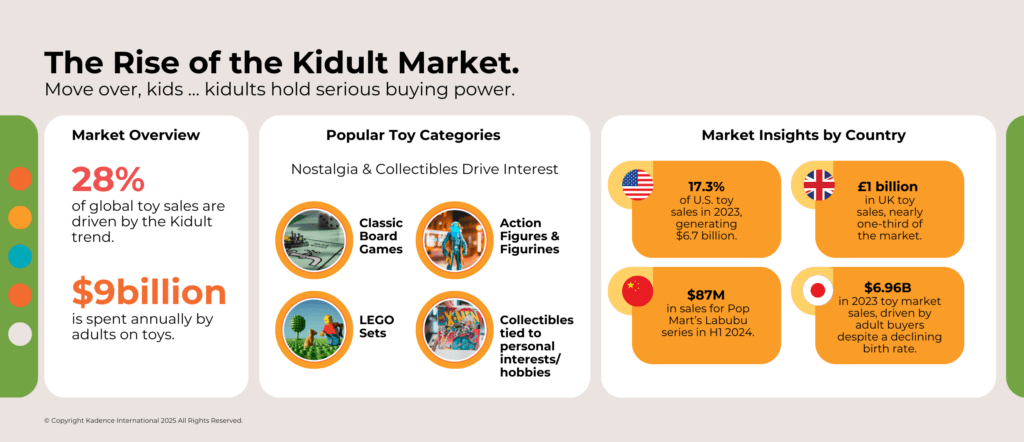
Case Study: Lego’s Strategic Pivot to Capturing the Kidult Market
Image Credit: Lego
Lego, known for its interlocking brick sets, has skillfully targeted the growing kidult demographic. Recognising the growing demand among adults for complex and nostalgic play experiences, Lego expanded its product line to include intricate sets that appeal to mature consumers.
In 2024, Lego reported a 6% increase in sales, largely attributed to the popularity of its Botanics flower sets specifically designed for older consumers. These sets offer a blend of creativity and relaxation, resonating with adults seeking mindful activities. Lego’s collaborations with popular franchises have bolstered its appeal to the kidult market. Lego taps into the nostalgia and fandoms that drive adult toy purchasing decisions by producing detailed models tied to beloved series.
Lego’s success with the kidult segment shows the value of catering to adult consumers’ desires for nostalgic and hands-on experiences.
What Toys are Kidults Buying?
Kidults are not just a niche segment – they are the backbone of the toy industry’s growth. While they make up only a quarter of total toy buyers, they account for 60% of dollar growth, according to NPD’s Checkout data. Their willingness to pay for premium products has created a revenue stream that far outpaces spending by parents buying for children.
Unlike cost-conscious parents who seek budget-friendly options, kidults gravitate toward collectibles, high-quality models, and limited-edition releases with higher price points. Their spending is not dictated by seasonality in the same way as traditional toy buyers. While holiday shopping remains a peak sales period, this audience purchases year-round, making them a more predictable and stable consumer base.
This shift has allowed toy companies to move beyond the cyclical boom-and-bust nature of holiday-driven sales. Even as inventory challenges and inflation pressure retailers, demand from kidults has remained strong. As a result, brands are increasingly designing marketing campaigns and product launches with this audience in mind, ensuring their place as a long-term driver of industry revenue.
Marketing Strategies For Toy Brands Targeting Kidults
Toy brands no longer rely on traditional retail displays or children’s TV ads to drive sales. Instead, they target kids where they are most engaged – on social media, in collector communities, and through direct-to-consumer platforms. Digital-first campaigns, influencer collaborations, and nostalgia-driven storytelling have become essential tools for capturing this audience.
Limited-edition drops and exclusive collaborations create a sense of urgency and exclusivity that resonates with collectors. Brands like Lego and Mattel have successfully leveraged pre-orders and premium-tier product launches to tap into this demand. Hasbro’s Black Series and Mattel’s Hot Wheels Red Line Club offer high-end collectables directly to fans, bypassing mass-market retail channels and reinforcing brand loyalty.
Community engagement is also key. Toy companies invest in fan-driven events, interactive content, and product tie-ins with entertainment franchises to keep their audiences invested. This approach has expanded beyond the toy aisle – adult-focused toy marketing now includes lifestyle branding, apparel collaborations, and interactive experiences designed to deepen brand attachment.
The brands that understand how to market to kidults are not just selling toys – they are selling identity, nostalgia, and belonging.
Case Study: Pop Mart’s Success with Labubu Collectibles
Image Credit: Los Angeles Times
Pop Mart, a Chinese toy company, has achieved remarkable success by targeting the adult market with its Labubu collectable figures. Created by Hong Kong artist Kasing Lung, Labubu features distinctive rabbit-like ears and spiky teeth, appealing primarily to adults seeking nostalgic and comforting collectables. Priced between $15 and $85, these figurines often sell out within minutes of restocking, leading fans to rely on group chats for updates and endure long lines. Celebrity endorsements, particularly from Lisa of Blackpink, have further boosted Labubu’s popularity. Collectors view these toys not just as playthings but as art pieces that add personality to their homes. Despite the prevalence of knockoffs, demand for Labubu continues to grow, with Pop Mart expanding its presence in the U.S. and reporting strong sales figures. This trend reflects a broader rise in kidult-targeted emotional comfort toys.
The Future of the Toy Industry Belongs to Adults
Kidults are not just spending – they are shaping the industry’s future. The brands that continue to evolve, embracing technology, sustainability, and personalisation, will lead the next evolution of the toy market. Augmented reality experiences, app-connected toys, and AI-powered collectables are emerging as the next “it” toys, blending nostalgia with modern tech. Eco-conscious buyers also influence brands to redesign packaging, adopt sustainable materials, and explore digital collectables.
The next step for brands is clear: those who embrace innovation while preserving nostalgia will remain at the forefront of this booming market.
For your research needs, trust insights that drive real impact. Whether you’re exploring consumer trends, market opportunities, or brand strategies, our expertise ensures you stay ahead. Get in touch to unlock data-driven success for your brand.
Get regular insights
Keep up to date with the latest insights from our research as well as all our company news in our free monthly newsletter.

A pair of limited-edition sneakers sells out in seconds. A countdown timer warns shoppers to buy now—or miss out. An influencer teases an exclusive event, restricted to a select few. Despite a surplus of consumer choices, brands are making products deliberately harder to buy.
Scarcity, urgency, and FOMO—the fear of missing out—have become core strategies in modern marketing, shaping how consumers shop and perceive value. What once seemed like organic demand is now carefully engineered. From luxury brands restricting supply to streaming services pulling content after 24 hours, the result is the same: consumers feel pressured to act before it’s too late.
How did brands turn psychology into a marketing machine? And when does persuasion cross into manipulation? As companies refine these tactics, the ethics of influence are becoming harder to ignore.
Why Consumers React to Scarcity, Urgency, and FOMO
Consumers like to believe they make rational decisions, weighing options and choosing what best fits their needs. The reality? Decisions are often driven by instinct. Scarcity, urgency, and fear exploit cognitive biases, triggering impulse rather than logic.
Scarcity: The Fear of Limited Supply
Nothing fuels demand like the illusion of rarity. When something is harder to get, it feels more valuable. Behavioural economist Richard Thaler’s research supports this: scarcity drives desire. Luxury brands have perfected the game. Hermès doesn’t limit Birkin bag production due to material shortages—it’s a strategy to keep the bags exclusive. Tech companies use the same approach. PlayStation 5’s perpetual “out of stock” status during launch wasn’t just supply chain issues—it kept consumers hooked, waiting for their moment to buy.
Urgency: The Pressure of Time
Hesitation feels like a loss when the clock is ticking. The Zeigarnik Effect, a psychological tendency to remember unfinished tasks, drives consumers to complete a purchase before the window closes. E-commerce platforms have perfected this trigger. Amazon’s “Lightning Deals” refresh hourly, urging shoppers to act fast. Travel sites flash “Only 2 rooms left!” warnings to heighten anxiety. The result? Split-second decisions with little time for second thoughts.
FOMO: The Power of Social Influence
Social media has turned FOMO into a marketing force. Seeing friends attend exclusive events or snag limited drops triggers an urgency no ad campaign can match. Snapchat and Instagram Stories disappear after 24 hours, making users compulsively check-in. Brands engineer this further with invitation-only product launches – think Clubhouse’s early-access model or Supreme’s drop culture. The goal isn’t just to sell; it’s to make consumers feel they’re part of something others can’t have.
Brands That Have Mastered Psychological Triggers
Some brands don’t just use scarcity, urgency, and FOMO; they’ve built their entire business models around them. They’ve turned these psychological levers into powerful revenue drivers by engineering desire and controlling access.
Hermès: The Art of Scarcity
No waiting lists. No online checkout. No guarantee of purchase even if you can afford it. The Hermès Birkin bag isn’t just a handbag; it’s a masterclass in controlled scarcity. By severely limiting production and requiring buyers to develop relationships with sales associates, Hermès ensures demand always outstrips supply. The result? A resale market where Birkins appreciate like investments, sometimes selling for double their retail price. In an industry where most items eventually go on sale, Hermès has made being unable to buy its product the ultimate status symbol.
Amazon: Urgency at Scale
E-commerce thrives on speed, and Amazon has utilised urgency better than anyone. Limited-time “Lightning Deals,” countdown timers, and messages like “Only 3 left in stock!” nudge consumers toward checkout. Prime Day, the company’s annual shopping event, is a prime example of when millions of deals disappear within hours, pushing shoppers to act fast. Amazon sells the anxiety of missing out on a bargain.
Supreme: FOMO in Its Purest Form
Supreme’s business model is built on hype. The streetwear brand’s infamous “drops” happen weekly, with products selling out in minutes, sometimes seconds. By keeping supply deliberately low and collaborating with high-profile brands, Supreme fuels a cycle of exclusivity and demand. Fans don’t just buy Supreme; they line up for hours to compete for the chance. With a resale market where items often fetch triple their original price, the brand has turned FOMO into a profitable ecosystem of scarcity-driven desire.
Social Commerce Meets FOMO with TikTok Shop:
TikTok has taken FOMO-driven shopping to a new level. By integrating e-commerce directly into its platform, the app encourages impulse purchases through time-sensitive deals and influencer-driven recommendations. “Only available for the next 24 hours” captions, live shopping events, and viral trends create a sense of now-or-never urgency. The difference? Consumers aren’t just buying from brands – they’re buying because their favourite creators make them feel like they’ll miss out if they don’t.
These brands are selling access, exclusivity, and the psychological rush of securing something before it’s gone. However, as consumers become more aware of these tactics, brands must ask themselves: how long before urgency turns into exhaustion?
Where Do Brands Draw the Line?
Scarcity, urgency, and FOMO are undeniably effective, but when does persuasion cross into manipulation? As brands push these psychological triggers harder, consumers are starting to push back.
Artificial Scarcity – Manufacturing Hype or Deception?
Not all scarcity is real. Some brands intentionally create stock shortages to generate buzz, only to quietly restock later. Luxury brands have long used this tactic, but now, even fast-fashion and tech companies are adopting it. Many product releases “sell out” in minutes, only reappearing later on resale platforms at inflated prices. The illusion of exclusivity works, but at what cost? Consumers are growing wary of brands that manufacture demand rather than earn it.
Urgency Fatigue – When Consumers Stop Caring
Constant countdown timers, flashing “limited stock” warnings, and one-day-only deals can lose their impact when overused. Studies show that consumers who repeatedly encounter false urgency eventually stop responding. Travel booking sites have faced regulatory scrutiny for exaggerating scarcity and listing “only one room left” when more are available. When urgency becomes routine rather than real, brands risk credibility.
FOMO Burnout – The Mental Toll on Consumers
Social media-driven FOMO isn’t just a marketing tool; it’s an emotional trigger. The pressure to stay ahead, secure the latest drop, or participate in an exclusive event can lead to anxiety and compulsive spending. A survey by Credit Karma found that nearly 40% of millennials have gone into debt because of FOMO-fueled purchases. Brands that lean too heavily on this strategy risk alienating consumers who feel manipulated rather than empowered.
Regulation and Consumer Backlash
Regulators are beginning to crack down. The UK’s Competition and Markets Authority (CMA) has fined companies for misleading urgency tactics. In the U.S., the Federal Trade Commission (FTC) has warned brands against deceptive scarcity claims. Consumers, too, are becoming more vocal, calling out brands for fake limited editions and “forever sales.”
Scarcity, urgency, and FOMO can drive engagement, but brands that misuse these tactics risk long-term damage. Once lost, trust is difficult to regain. The challenge now is clear: how can brands create real value?
How Brands Can Apply Psychological Triggers Effectively
Scarcity, urgency, and FOMO aren’t inherently unethical when used correctly, they can enhance customer experience, create meaningful engagement, and drive sales without alienating consumers. The key is authenticity. Brands that use these psychological triggers responsibly build stronger relationships with their audience, while those that rely on deception risk losing credibility.
Authentic Scarcity – When Limited Means Limited
Consumers can spot artificial scarcity. If a product is marketed as exclusive but keeps reappearing, trust erodes. Instead, brands should create real constraints, whether through limited production runs, seasonal availability, or exclusive collaborations. Hermès maintains exclusivity by restricting supply, while high-end automotive brands use limited releases to sustain long-term desirability.
Strategic Urgency – Pressure Without Manipulation
Urgency works best when it feels natural, not forced. Time-sensitive promotions should be genuine, like early-bird event pricing, flash sales with clear expiration dates, or rewards for loyal customers who act quickly. Travel companies, after facing scrutiny for misleading urgency tactics, are shifting toward more transparent messaging, highlighting real-time booking trends rather than fabricating scarcity.
FOMO-Driven Engagement – Creating Experiences, Not Just Sales
FOMO doesn’t have to be about fear; it can be about excitement and belonging. Brands that foster community-driven experiences see long-term success. Exclusive memberships, VIP access, and interactive product launches tap into the power of FOMO while providing real value. For instance, TikTok’s live shopping feature blends urgency with entertainment, encouraging consumers to engage rather than feel pressured.
The Long Game – Balancing Demand with Trust
Short-term sales tactics can generate immediate results, but brands that rely too heavily on them risk fatigue. The most successful companies use scarcity, urgency, and FOMO sparingly, ensuring that when they do, it feels special. Transparency is key. If consumers understand why a product is limited, why a sale is ending, or why an offer is exclusive, they’re more likely to trust the brand and return for future purchases.
Scarcity, urgency, and FOMO are some of the most powerful marketing tools, but their real strength lies in their use. Brands that use them responsibly will not only drive conversions but also build lasting loyalty in a market where trust is harder to earn than ever.
The Future of Scarcity, Urgency, and FOMO in Marketing
As consumers grow savvier, brands must rethink how they use psychological triggers. The old playbook – endless countdown timers, fake exclusivity, and misleading urgency – no longer works. Trust is becoming the new currency, and brands that misuse these tactics risk long-term damage.
AI-Driven Personalisation – The Next Evolution of Urgency
Instead of blasting the same urgency messages to everyone, brands now leverage AI to make scarcity and FOMO feel personal. E-commerce platforms analyze browsing habits and purchase history to create dynamic, hyper-targeted urgency. Rather than generic “Only 3 left in stock!” alerts, AI can now tell a shopper, “This item has been viewed 200 times in the past hour by customers in your city.” This shift makes urgency more relevant and harder to ignore.
Web3 and Digital Scarcity – The New Luxury?
Blockchain is reshaping the concept of exclusivity. NFTs, tokenised memberships, and limited digital assets are turning scarcity into a verified, traceable feature rather than a marketing gimmick. In fashion and entertainment, brands are experimenting with “phygital” drops, where limited-edition physical products are tied to digital ownership, making them impossible to replicate or mass-produce. The result? Scarcity that is verifiable, not just implied.
The Consumer Backlash: Brands Walking a Fine Line
Consumers are pushing back against overused urgency tactics. The rise of anti-FOMO movements, such as the slow fashion trend, conscious consumerism, and “buy less, buy better” messaging, signals a shift away from impulse-driven spending. Brands that continue to rely on aggressive scarcity marketing without delivering real value could find themselves losing consumer trust.
The Shift Toward Ethical Marketing
Regulations will only get stricter, and consumer expectations will only rise. The future belongs to brands that create demand without deception – companies that balance excitement with authenticity. Whether through genuine exclusivity, AI-powered personalisation, or blockchain-backed scarcity, the next wave of marketing won’t be about forcing consumers to act. It will be about making them want to.
Urgency still matters with fleeting attention spans. But in the future, the most successful brands will not just create FOMO – they’ll create something worth waiting for.
The Fine Line Between Influence and Manipulation
Scarcity, urgency, and FOMO have shaped modern marketing, but they are no longer foolproof tactics. Consumers today are more informed, more sceptical, and less willing to be pressured into making purchases. The brands that continue to rely on outdated urgency tricks risk alienating their audience, while those that evolve will be the ones that thrive.
The future of marketing isn’t about manufacturing demand; it’s about meeting it in smarter ways. Real scarcity, backed by transparent supply constraints. Urgency that reflects genuine time-sensitive value, not fabricated pressure. FOMO that fuels community and belonging rather than consumer anxiety.
The brands that win in this landscape will be the ones that recognise a simple truth: consumers don’t just want to buy; they want to believe. And belief is built on trust, not tricks.
Get regular insights
Keep up to date with the latest insights from our research as well as all our company news in our free monthly newsletter.








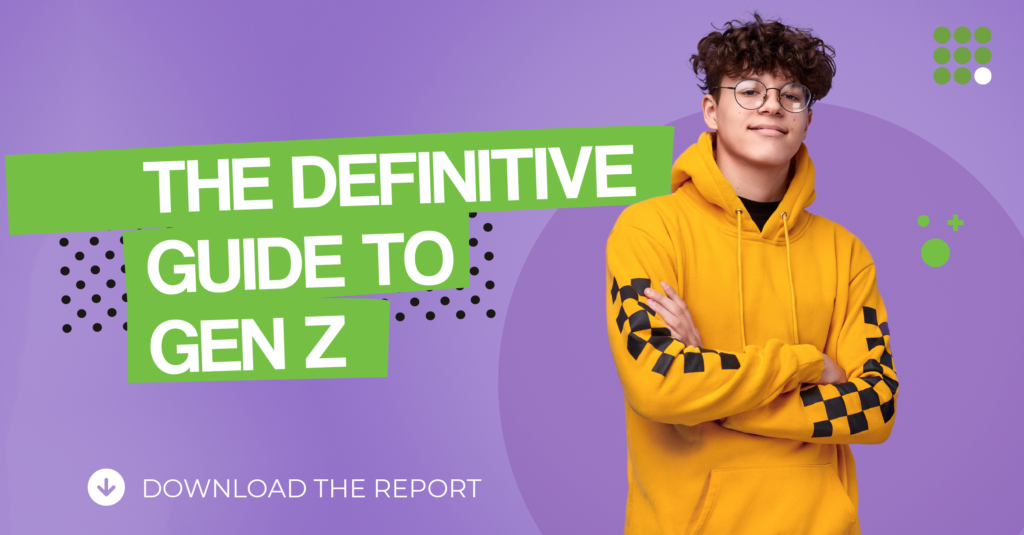






 Senior Marketing Executive
Senior Marketing Executive Sales & Marketing
Sales & Marketing General Manager PR -Internal Communications & Government Affairs
General Manager PR -Internal Communications & Government Affairs Vital Strategies
Vital Strategies
 Customer Intelligence Director
Customer Intelligence Director